Local Knowledge & Agricultural Practices | Madagascar
VerifiedAdded on 2022/07/05
|21
|9626
|29
AI Summary
This paper presents On the east coast of Madagascar, farmers rely on clove tree products to assure household food security. The Malagasy farmers are changing their farming practices in the clove crop production and diversifying species to improve their farming systems. This paper presents the principal findings of the multidisciplinary survey conducted during a 4-month field study in Madagascar. The study was completed with Bestimisaraka farmers from two communities in the clove-growing area. Farmers’ knowledge of clove trees and origins and practices.
Contribute Materials
Your contribution can guide someone’s learning journey. Share your
documents today.
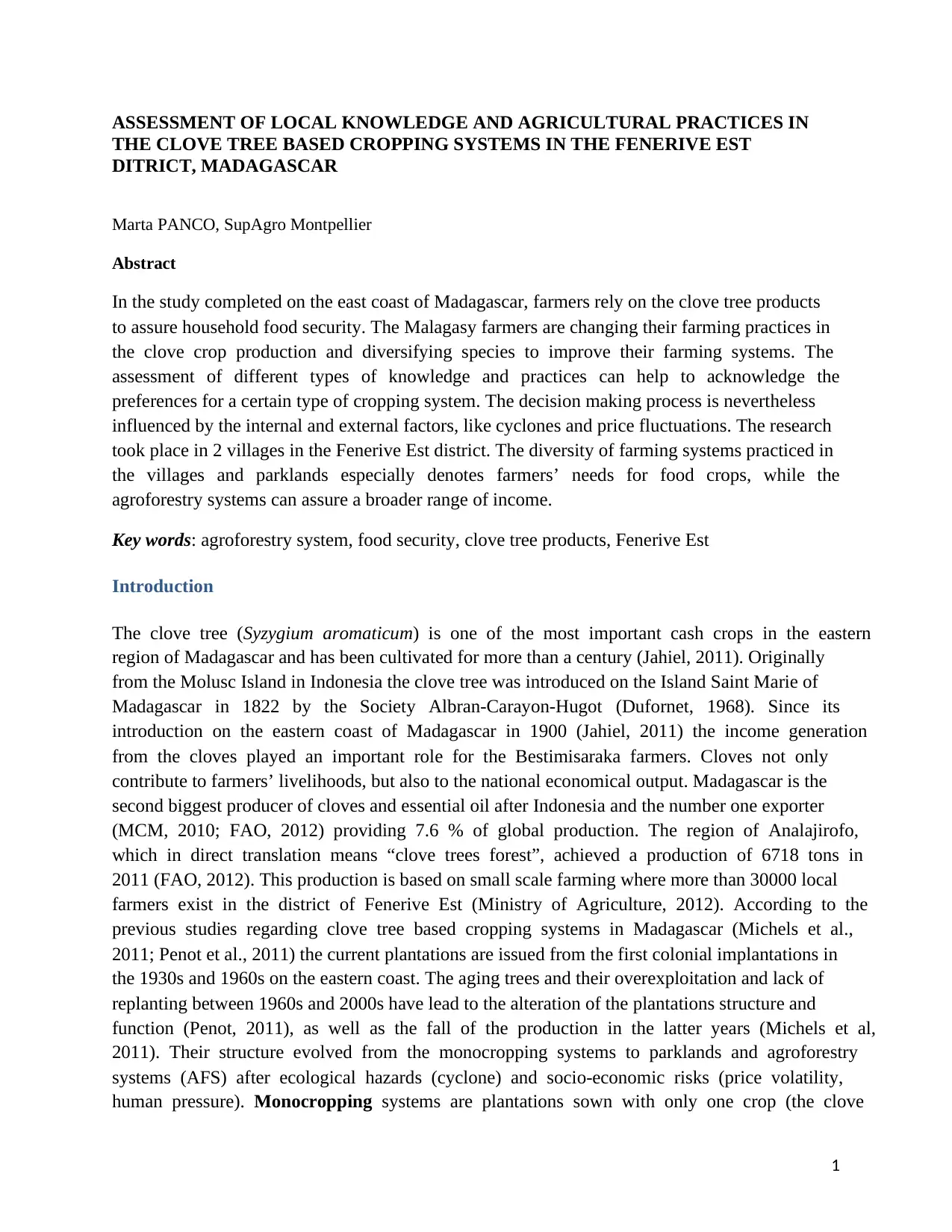
1
ASSESSMENT OF LOCAL KNOWLEDGE AND AGRICULTURAL PRACTICES IN
THE CLOVE TREE BASED CROPPING SYSTEMS IN THE FENERIVE EST
DITRICT, MADAGASCAR
Marta PANCO, SupAgro Montpellier
Abstract
In the study completed on the east coast of Madagascar, farmers rely on the clove tree products
to assure household food security. The Malagasy farmers are changing their farming practices in
the clove crop production and diversifying species to improve their farming systems. The
assessment of different types of knowledge and practices can help to acknowledge the
preferences for a certain type of cropping system. The decision making process is nevertheless
influenced by the internal and external factors, like cyclones and price fluctuations. The research
took place in 2 villages in the Fenerive Est district. The diversity of farming systems practiced in
the villages and parklands especially denotes farmers’ needs for food crops, while the
agroforestry systems can assure a broader range of income.
Key words: agroforestry system, food security, clove tree products, Fenerive Est
Introduction
The clove tree (Syzygium aromaticum) is one of the most important cash crops in the eastern
region of Madagascar and has been cultivated for more than a century (Jahiel, 2011). Originally
from the Molusc Island in Indonesia the clove tree was introduced on the Island Saint Marie of
Madagascar in 1822 by the Society Albran-Carayon-Hugot (Dufornet, 1968). Since its
introduction on the eastern coast of Madagascar in 1900 (Jahiel, 2011) the income generation
from the cloves played an important role for the Bestimisaraka farmers. Cloves not only
contribute to farmers’ livelihoods, but also to the national economical output. Madagascar is the
second biggest producer of cloves and essential oil after Indonesia and the number one exporter
(MCM, 2010; FAO, 2012) providing 7.6 % of global production. The region of Analajirofo,
which in direct translation means “clove trees forest”, achieved a production of 6718 tons in
2011 (FAO, 2012). This production is based on small scale farming where more than 30000 local
farmers exist in the district of Fenerive Est (Ministry of Agriculture, 2012). According to the
previous studies regarding clove tree based cropping systems in Madagascar (Michels et al.,
2011; Penot et al., 2011) the current plantations are issued from the first colonial implantations in
the 1930s and 1960s on the eastern coast. The aging trees and their overexploitation and lack of
replanting between 1960s and 2000s have lead to the alteration of the plantations structure and
function (Penot, 2011), as well as the fall of the production in the latter years (Michels et al,
2011). Their structure evolved from the monocropping systems to parklands and agroforestry
systems (AFS) after ecological hazards (cyclone) and socio-economic risks (price volatility,
human pressure). Monocropping systems are plantations sown with only one crop (the clove
ASSESSMENT OF LOCAL KNOWLEDGE AND AGRICULTURAL PRACTICES IN
THE CLOVE TREE BASED CROPPING SYSTEMS IN THE FENERIVE EST
DITRICT, MADAGASCAR
Marta PANCO, SupAgro Montpellier
Abstract
In the study completed on the east coast of Madagascar, farmers rely on the clove tree products
to assure household food security. The Malagasy farmers are changing their farming practices in
the clove crop production and diversifying species to improve their farming systems. The
assessment of different types of knowledge and practices can help to acknowledge the
preferences for a certain type of cropping system. The decision making process is nevertheless
influenced by the internal and external factors, like cyclones and price fluctuations. The research
took place in 2 villages in the Fenerive Est district. The diversity of farming systems practiced in
the villages and parklands especially denotes farmers’ needs for food crops, while the
agroforestry systems can assure a broader range of income.
Key words: agroforestry system, food security, clove tree products, Fenerive Est
Introduction
The clove tree (Syzygium aromaticum) is one of the most important cash crops in the eastern
region of Madagascar and has been cultivated for more than a century (Jahiel, 2011). Originally
from the Molusc Island in Indonesia the clove tree was introduced on the Island Saint Marie of
Madagascar in 1822 by the Society Albran-Carayon-Hugot (Dufornet, 1968). Since its
introduction on the eastern coast of Madagascar in 1900 (Jahiel, 2011) the income generation
from the cloves played an important role for the Bestimisaraka farmers. Cloves not only
contribute to farmers’ livelihoods, but also to the national economical output. Madagascar is the
second biggest producer of cloves and essential oil after Indonesia and the number one exporter
(MCM, 2010; FAO, 2012) providing 7.6 % of global production. The region of Analajirofo,
which in direct translation means “clove trees forest”, achieved a production of 6718 tons in
2011 (FAO, 2012). This production is based on small scale farming where more than 30000 local
farmers exist in the district of Fenerive Est (Ministry of Agriculture, 2012). According to the
previous studies regarding clove tree based cropping systems in Madagascar (Michels et al.,
2011; Penot et al., 2011) the current plantations are issued from the first colonial implantations in
the 1930s and 1960s on the eastern coast. The aging trees and their overexploitation and lack of
replanting between 1960s and 2000s have lead to the alteration of the plantations structure and
function (Penot, 2011), as well as the fall of the production in the latter years (Michels et al,
2011). Their structure evolved from the monocropping systems to parklands and agroforestry
systems (AFS) after ecological hazards (cyclone) and socio-economic risks (price volatility,
human pressure). Monocropping systems are plantations sown with only one crop (the clove
Secure Best Marks with AI Grader
Need help grading? Try our AI Grader for instant feedback on your assignments.
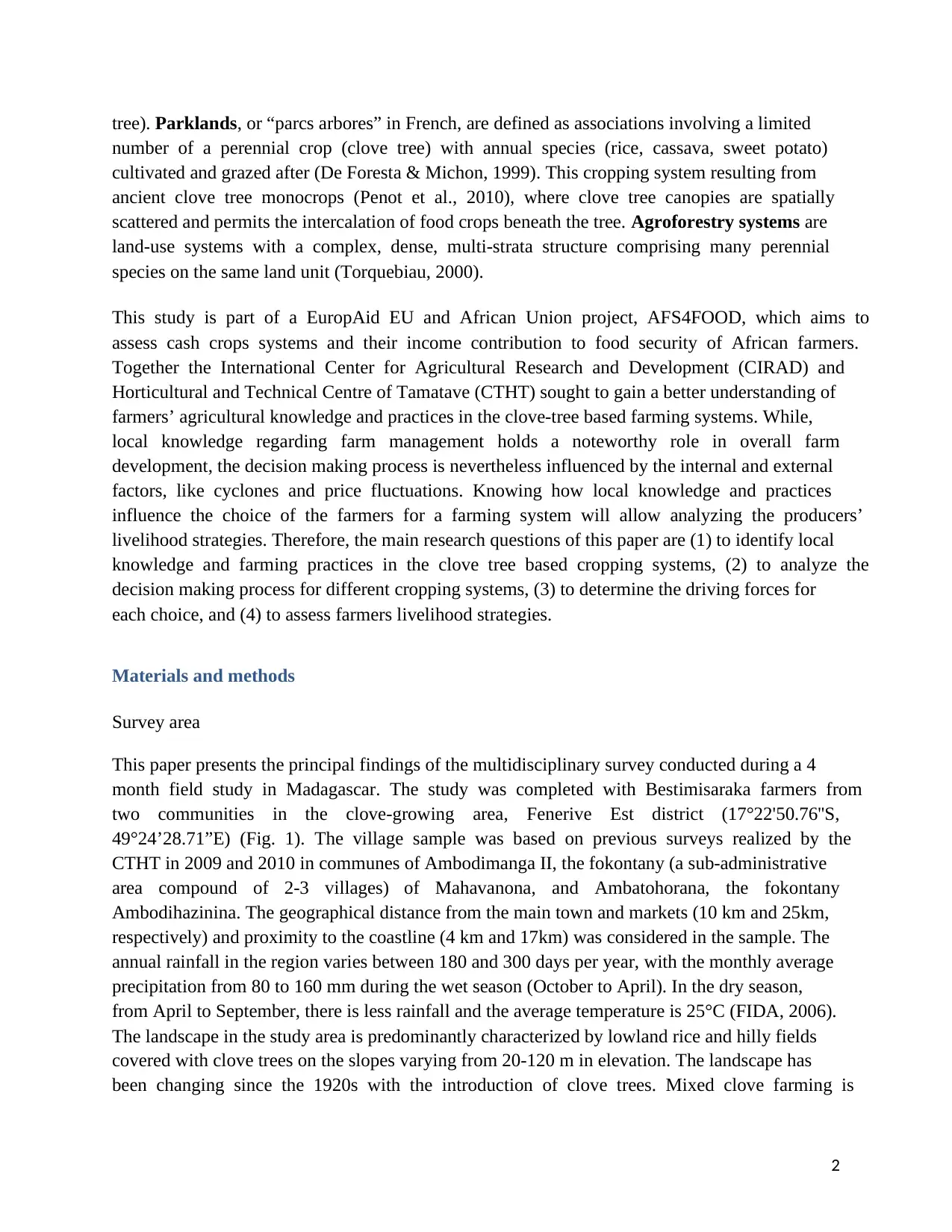
2
tree). Parklands, or “parcs arbores” in French, are defined as associations involving a limited
number of a perennial crop (clove tree) with annual species (rice, cassava, sweet potato)
cultivated and grazed after (De Foresta & Michon, 1999). This cropping system resulting from
ancient clove tree monocrops (Penot et al., 2010), where clove tree canopies are spatially
scattered and permits the intercalation of food crops beneath the tree. Agroforestry systems are
land-use systems with a complex, dense, multi-strata structure comprising many perennial
species on the same land unit (Torquebiau, 2000).
This study is part of a EuropAid EU and African Union project, AFS4FOOD, which aims to
assess cash crops systems and their income contribution to food security of African farmers.
Together the International Center for Agricultural Research and Development (CIRAD) and
Horticultural and Technical Centre of Tamatave (CTHT) sought to gain a better understanding of
farmers’ agricultural knowledge and practices in the clove-tree based farming systems. While,
local knowledge regarding farm management holds a noteworthy role in overall farm
development, the decision making process is nevertheless influenced by the internal and external
factors, like cyclones and price fluctuations. Knowing how local knowledge and practices
influence the choice of the farmers for a farming system will allow analyzing the producers’
livelihood strategies. Therefore, the main research questions of this paper are (1) to identify local
knowledge and farming practices in the clove tree based cropping systems, (2) to analyze the
decision making process for different cropping systems, (3) to determine the driving forces for
each choice, and (4) to assess farmers livelihood strategies.
Materials and methods
Survey area
This paper presents the principal findings of the multidisciplinary survey conducted during a 4
month field study in Madagascar. The study was completed with Bestimisaraka farmers from
two communities in the clove-growing area, Fenerive Est district (17°22'50.76''S,
49°24’28.71”E) (Fig. 1). The village sample was based on previous surveys realized by the
CTHT in 2009 and 2010 in communes of Ambodimanga II, the fokontany (a sub-administrative
area compound of 2-3 villages) of Mahavanona, and Ambatohorana, the fokontany
Ambodihazinina. The geographical distance from the main town and markets (10 km and 25km,
respectively) and proximity to the coastline (4 km and 17km) was considered in the sample. The
annual rainfall in the region varies between 180 and 300 days per year, with the monthly average
precipitation from 80 to 160 mm during the wet season (October to April). In the dry season,
from April to September, there is less rainfall and the average temperature is 25°C (FIDA, 2006).
The landscape in the study area is predominantly characterized by lowland rice and hilly fields
covered with clove trees on the slopes varying from 20-120 m in elevation. The landscape has
been changing since the 1920s with the introduction of clove trees. Mixed clove farming is
tree). Parklands, or “parcs arbores” in French, are defined as associations involving a limited
number of a perennial crop (clove tree) with annual species (rice, cassava, sweet potato)
cultivated and grazed after (De Foresta & Michon, 1999). This cropping system resulting from
ancient clove tree monocrops (Penot et al., 2010), where clove tree canopies are spatially
scattered and permits the intercalation of food crops beneath the tree. Agroforestry systems are
land-use systems with a complex, dense, multi-strata structure comprising many perennial
species on the same land unit (Torquebiau, 2000).
This study is part of a EuropAid EU and African Union project, AFS4FOOD, which aims to
assess cash crops systems and their income contribution to food security of African farmers.
Together the International Center for Agricultural Research and Development (CIRAD) and
Horticultural and Technical Centre of Tamatave (CTHT) sought to gain a better understanding of
farmers’ agricultural knowledge and practices in the clove-tree based farming systems. While,
local knowledge regarding farm management holds a noteworthy role in overall farm
development, the decision making process is nevertheless influenced by the internal and external
factors, like cyclones and price fluctuations. Knowing how local knowledge and practices
influence the choice of the farmers for a farming system will allow analyzing the producers’
livelihood strategies. Therefore, the main research questions of this paper are (1) to identify local
knowledge and farming practices in the clove tree based cropping systems, (2) to analyze the
decision making process for different cropping systems, (3) to determine the driving forces for
each choice, and (4) to assess farmers livelihood strategies.
Materials and methods
Survey area
This paper presents the principal findings of the multidisciplinary survey conducted during a 4
month field study in Madagascar. The study was completed with Bestimisaraka farmers from
two communities in the clove-growing area, Fenerive Est district (17°22'50.76''S,
49°24’28.71”E) (Fig. 1). The village sample was based on previous surveys realized by the
CTHT in 2009 and 2010 in communes of Ambodimanga II, the fokontany (a sub-administrative
area compound of 2-3 villages) of Mahavanona, and Ambatohorana, the fokontany
Ambodihazinina. The geographical distance from the main town and markets (10 km and 25km,
respectively) and proximity to the coastline (4 km and 17km) was considered in the sample. The
annual rainfall in the region varies between 180 and 300 days per year, with the monthly average
precipitation from 80 to 160 mm during the wet season (October to April). In the dry season,
from April to September, there is less rainfall and the average temperature is 25°C (FIDA, 2006).
The landscape in the study area is predominantly characterized by lowland rice and hilly fields
covered with clove trees on the slopes varying from 20-120 m in elevation. The landscape has
been changing since the 1920s with the introduction of clove trees. Mixed clove farming is
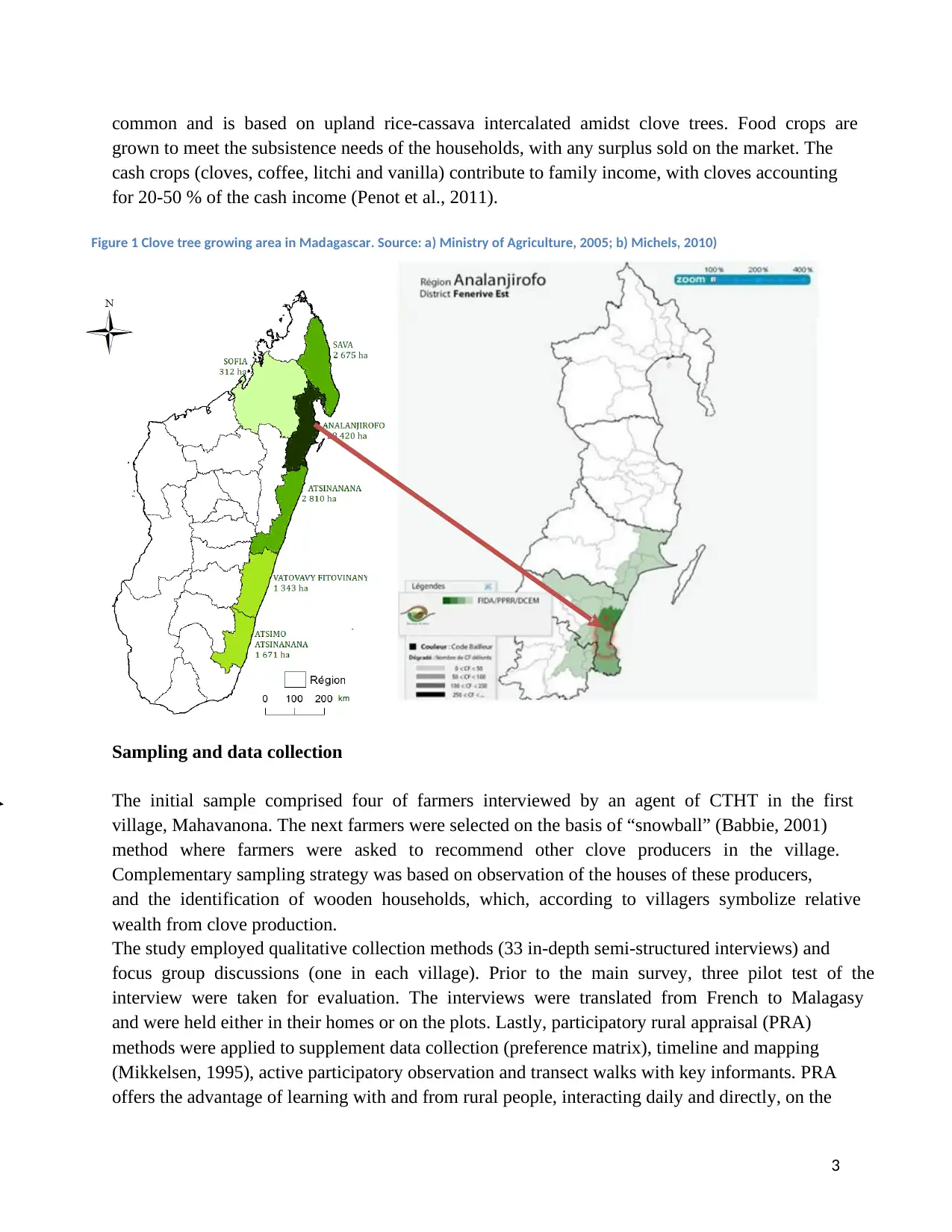
3
common and is based on upland rice-cassava intercalated amidst clove trees. Food crops are
grown to meet the subsistence needs of the households, with any surplus sold on the market. The
cash crops (cloves, coffee, litchi and vanilla) contribute to family income, with cloves accounting
for 20-50 % of the cash income (Penot et al., 2011).
Sampling and data collection
The initial sample comprised four of farmers interviewed by an agent of CTHT in the first
village, Mahavanona. The next farmers were selected on the basis of “snowball” (Babbie, 2001)
method where farmers were asked to recommend other clove producers in the village.
Complementary sampling strategy was based on observation of the houses of these producers,
and the identification of wooden households, which, according to villagers symbolize relative
wealth from clove production.
The study employed qualitative collection methods (33 in-depth semi-structured interviews) and
focus group discussions (one in each village). Prior to the main survey, three pilot test of the
interview were taken for evaluation. The interviews were translated from French to Malagasy
and were held either in their homes or on the plots. Lastly, participatory rural appraisal (PRA)
methods were applied to supplement data collection (preference matrix), timeline and mapping
(Mikkelsen, 1995), active participatory observation and transect walks with key informants. PRA
offers the advantage of learning with and from rural people, interacting daily and directly, on the
Figure 1 Clove tree growing area in Madagascar. Source: a) Ministry of Agriculture, 2005; b) Michels, 2010)
common and is based on upland rice-cassava intercalated amidst clove trees. Food crops are
grown to meet the subsistence needs of the households, with any surplus sold on the market. The
cash crops (cloves, coffee, litchi and vanilla) contribute to family income, with cloves accounting
for 20-50 % of the cash income (Penot et al., 2011).
Sampling and data collection
The initial sample comprised four of farmers interviewed by an agent of CTHT in the first
village, Mahavanona. The next farmers were selected on the basis of “snowball” (Babbie, 2001)
method where farmers were asked to recommend other clove producers in the village.
Complementary sampling strategy was based on observation of the houses of these producers,
and the identification of wooden households, which, according to villagers symbolize relative
wealth from clove production.
The study employed qualitative collection methods (33 in-depth semi-structured interviews) and
focus group discussions (one in each village). Prior to the main survey, three pilot test of the
interview were taken for evaluation. The interviews were translated from French to Malagasy
and were held either in their homes or on the plots. Lastly, participatory rural appraisal (PRA)
methods were applied to supplement data collection (preference matrix), timeline and mapping
(Mikkelsen, 1995), active participatory observation and transect walks with key informants. PRA
offers the advantage of learning with and from rural people, interacting daily and directly, on the
Figure 1 Clove tree growing area in Madagascar. Source: a) Ministry of Agriculture, 2005; b) Michels, 2010)
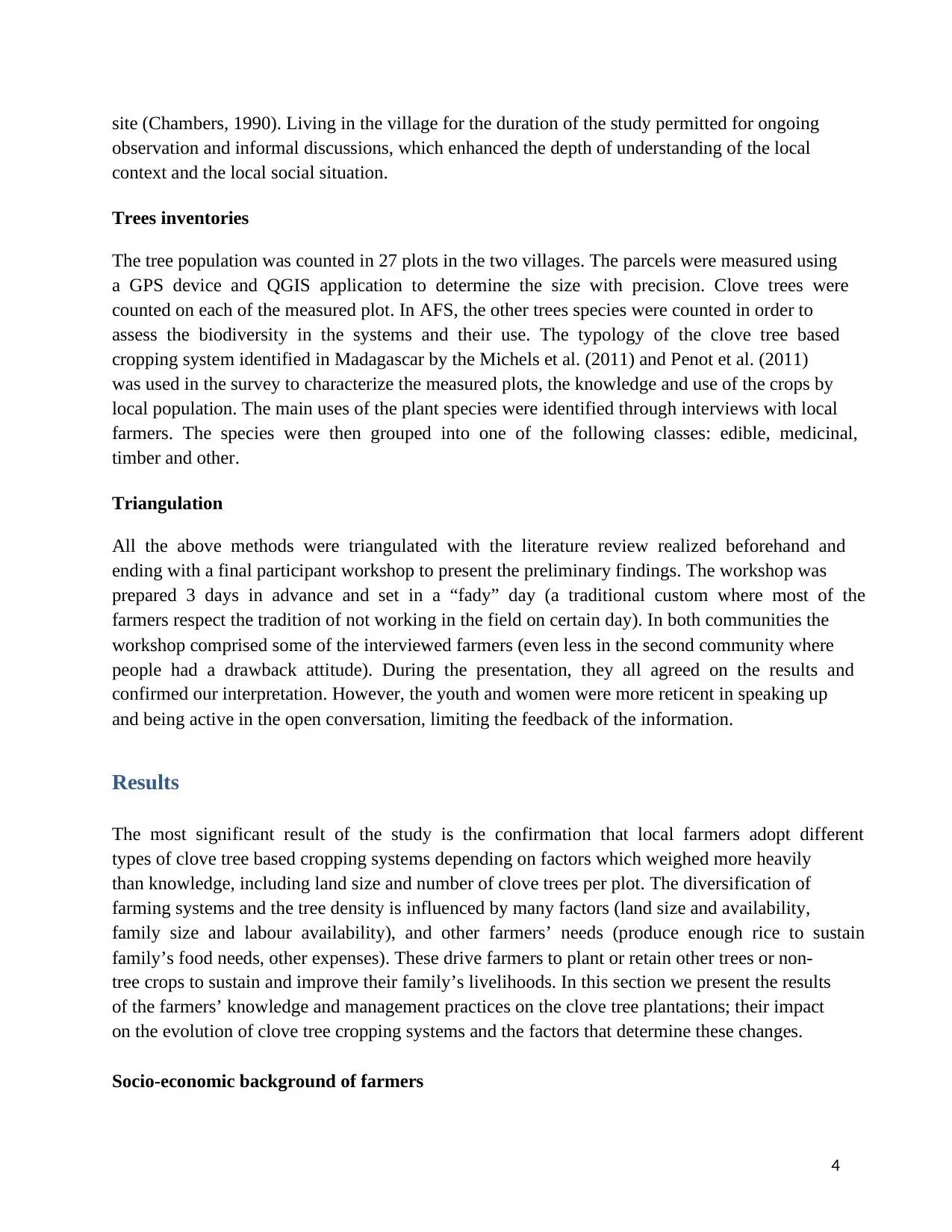
4
site (Chambers, 1990). Living in the village for the duration of the study permitted for ongoing
observation and informal discussions, which enhanced the depth of understanding of the local
context and the local social situation.
Trees inventories
The tree population was counted in 27 plots in the two villages. The parcels were measured using
a GPS device and QGIS application to determine the size with precision. Clove trees were
counted on each of the measured plot. In AFS, the other trees species were counted in order to
assess the biodiversity in the systems and their use. The typology of the clove tree based
cropping system identified in Madagascar by the Michels et al. (2011) and Penot et al. (2011)
was used in the survey to characterize the measured plots, the knowledge and use of the crops by
local population. The main uses of the plant species were identified through interviews with local
farmers. The species were then grouped into one of the following classes: edible, medicinal,
timber and other.
Triangulation
All the above methods were triangulated with the literature review realized beforehand and
ending with a final participant workshop to present the preliminary findings. The workshop was
prepared 3 days in advance and set in a “fady” day (a traditional custom where most of the
farmers respect the tradition of not working in the field on certain day). In both communities the
workshop comprised some of the interviewed farmers (even less in the second community where
people had a drawback attitude). During the presentation, they all agreed on the results and
confirmed our interpretation. However, the youth and women were more reticent in speaking up
and being active in the open conversation, limiting the feedback of the information.
Results
The most significant result of the study is the confirmation that local farmers adopt different
types of clove tree based cropping systems depending on factors which weighed more heavily
than knowledge, including land size and number of clove trees per plot. The diversification of
farming systems and the tree density is influenced by many factors (land size and availability,
family size and labour availability), and other farmers’ needs (produce enough rice to sustain
family’s food needs, other expenses). These drive farmers to plant or retain other trees or non-
tree crops to sustain and improve their family’s livelihoods. In this section we present the results
of the farmers’ knowledge and management practices on the clove tree plantations; their impact
on the evolution of clove tree cropping systems and the factors that determine these changes.
Socio-economic background of farmers
site (Chambers, 1990). Living in the village for the duration of the study permitted for ongoing
observation and informal discussions, which enhanced the depth of understanding of the local
context and the local social situation.
Trees inventories
The tree population was counted in 27 plots in the two villages. The parcels were measured using
a GPS device and QGIS application to determine the size with precision. Clove trees were
counted on each of the measured plot. In AFS, the other trees species were counted in order to
assess the biodiversity in the systems and their use. The typology of the clove tree based
cropping system identified in Madagascar by the Michels et al. (2011) and Penot et al. (2011)
was used in the survey to characterize the measured plots, the knowledge and use of the crops by
local population. The main uses of the plant species were identified through interviews with local
farmers. The species were then grouped into one of the following classes: edible, medicinal,
timber and other.
Triangulation
All the above methods were triangulated with the literature review realized beforehand and
ending with a final participant workshop to present the preliminary findings. The workshop was
prepared 3 days in advance and set in a “fady” day (a traditional custom where most of the
farmers respect the tradition of not working in the field on certain day). In both communities the
workshop comprised some of the interviewed farmers (even less in the second community where
people had a drawback attitude). During the presentation, they all agreed on the results and
confirmed our interpretation. However, the youth and women were more reticent in speaking up
and being active in the open conversation, limiting the feedback of the information.
Results
The most significant result of the study is the confirmation that local farmers adopt different
types of clove tree based cropping systems depending on factors which weighed more heavily
than knowledge, including land size and number of clove trees per plot. The diversification of
farming systems and the tree density is influenced by many factors (land size and availability,
family size and labour availability), and other farmers’ needs (produce enough rice to sustain
family’s food needs, other expenses). These drive farmers to plant or retain other trees or non-
tree crops to sustain and improve their family’s livelihoods. In this section we present the results
of the farmers’ knowledge and management practices on the clove tree plantations; their impact
on the evolution of clove tree cropping systems and the factors that determine these changes.
Socio-economic background of farmers
Secure Best Marks with AI Grader
Need help grading? Try our AI Grader for instant feedback on your assignments.
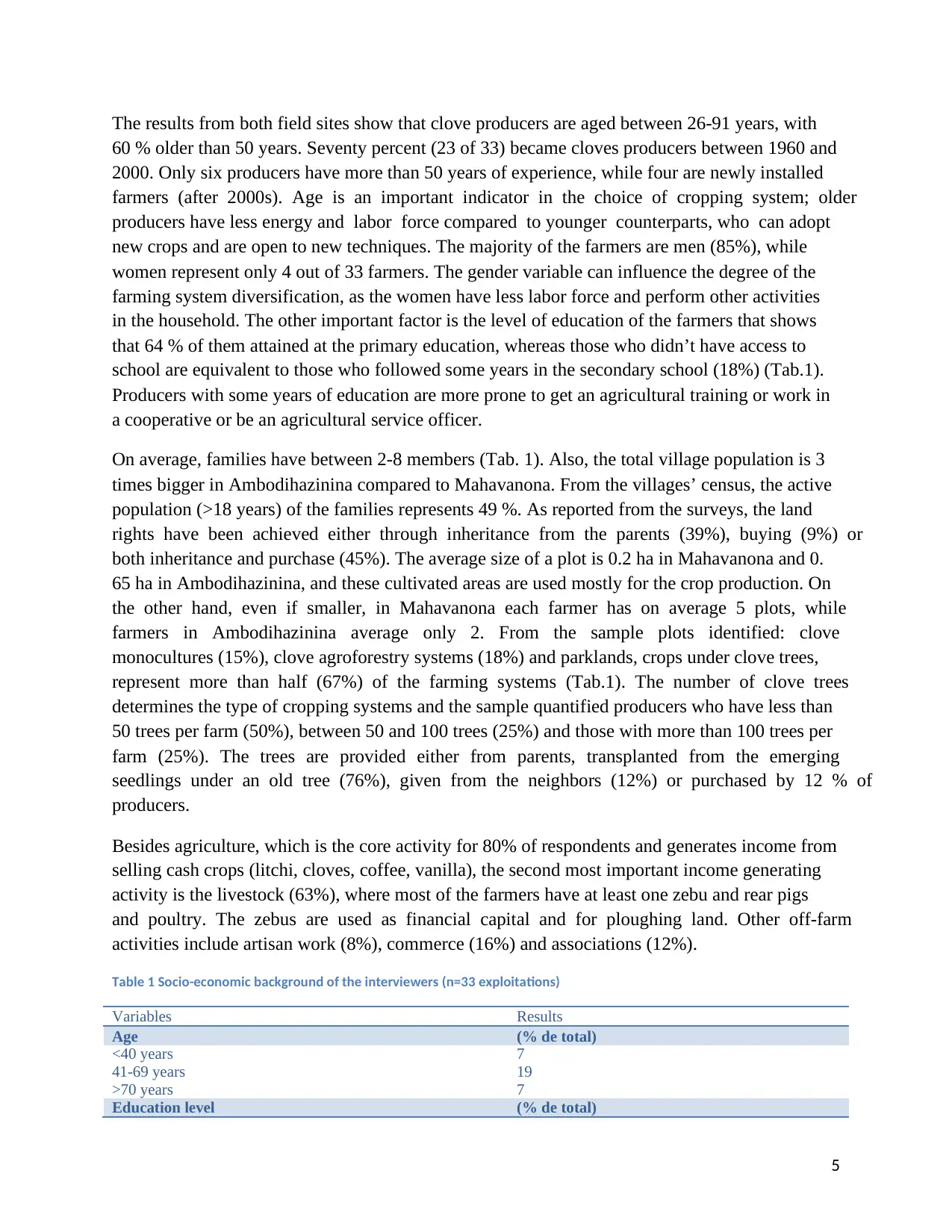
5
The results from both field sites show that clove producers are aged between 26-91 years, with
60 % older than 50 years. Seventy percent (23 of 33) became cloves producers between 1960 and
2000. Only six producers have more than 50 years of experience, while four are newly installed
farmers (after 2000s). Age is an important indicator in the choice of cropping system; older
producers have less energy and labor force compared to younger counterparts, who can adopt
new crops and are open to new techniques. The majority of the farmers are men (85%), while
women represent only 4 out of 33 farmers. The gender variable can influence the degree of the
farming system diversification, as the women have less labor force and perform other activities
in the household. The other important factor is the level of education of the farmers that shows
that 64 % of them attained at the primary education, whereas those who didn’t have access to
school are equivalent to those who followed some years in the secondary school (18%) (Tab.1).
Producers with some years of education are more prone to get an agricultural training or work in
a cooperative or be an agricultural service officer.
On average, families have between 2-8 members (Tab. 1). Also, the total village population is 3
times bigger in Ambodihazinina compared to Mahavanona. From the villages’ census, the active
population (>18 years) of the families represents 49 %. As reported from the surveys, the land
rights have been achieved either through inheritance from the parents (39%), buying (9%) or
both inheritance and purchase (45%). The average size of a plot is 0.2 ha in Mahavanona and 0.
65 ha in Ambodihazinina, and these cultivated areas are used mostly for the crop production. On
the other hand, even if smaller, in Mahavanona each farmer has on average 5 plots, while
farmers in Ambodihazinina average only 2. From the sample plots identified: clove
monocultures (15%), clove agroforestry systems (18%) and parklands, crops under clove trees,
represent more than half (67%) of the farming systems (Tab.1). The number of clove trees
determines the type of cropping systems and the sample quantified producers who have less than
50 trees per farm (50%), between 50 and 100 trees (25%) and those with more than 100 trees per
farm (25%). The trees are provided either from parents, transplanted from the emerging
seedlings under an old tree (76%), given from the neighbors (12%) or purchased by 12 % of
producers.
Besides agriculture, which is the core activity for 80% of respondents and generates income from
selling cash crops (litchi, cloves, coffee, vanilla), the second most important income generating
activity is the livestock (63%), where most of the farmers have at least one zebu and rear pigs
and poultry. The zebus are used as financial capital and for ploughing land. Other off-farm
activities include artisan work (8%), commerce (16%) and associations (12%).
Table 1 Socio-economic background of the interviewers (n=33 exploitations)
Variables Results
Age (% de total)
<40 years
41-69 years
>70 years
7
19
7
Education level (% de total)
The results from both field sites show that clove producers are aged between 26-91 years, with
60 % older than 50 years. Seventy percent (23 of 33) became cloves producers between 1960 and
2000. Only six producers have more than 50 years of experience, while four are newly installed
farmers (after 2000s). Age is an important indicator in the choice of cropping system; older
producers have less energy and labor force compared to younger counterparts, who can adopt
new crops and are open to new techniques. The majority of the farmers are men (85%), while
women represent only 4 out of 33 farmers. The gender variable can influence the degree of the
farming system diversification, as the women have less labor force and perform other activities
in the household. The other important factor is the level of education of the farmers that shows
that 64 % of them attained at the primary education, whereas those who didn’t have access to
school are equivalent to those who followed some years in the secondary school (18%) (Tab.1).
Producers with some years of education are more prone to get an agricultural training or work in
a cooperative or be an agricultural service officer.
On average, families have between 2-8 members (Tab. 1). Also, the total village population is 3
times bigger in Ambodihazinina compared to Mahavanona. From the villages’ census, the active
population (>18 years) of the families represents 49 %. As reported from the surveys, the land
rights have been achieved either through inheritance from the parents (39%), buying (9%) or
both inheritance and purchase (45%). The average size of a plot is 0.2 ha in Mahavanona and 0.
65 ha in Ambodihazinina, and these cultivated areas are used mostly for the crop production. On
the other hand, even if smaller, in Mahavanona each farmer has on average 5 plots, while
farmers in Ambodihazinina average only 2. From the sample plots identified: clove
monocultures (15%), clove agroforestry systems (18%) and parklands, crops under clove trees,
represent more than half (67%) of the farming systems (Tab.1). The number of clove trees
determines the type of cropping systems and the sample quantified producers who have less than
50 trees per farm (50%), between 50 and 100 trees (25%) and those with more than 100 trees per
farm (25%). The trees are provided either from parents, transplanted from the emerging
seedlings under an old tree (76%), given from the neighbors (12%) or purchased by 12 % of
producers.
Besides agriculture, which is the core activity for 80% of respondents and generates income from
selling cash crops (litchi, cloves, coffee, vanilla), the second most important income generating
activity is the livestock (63%), where most of the farmers have at least one zebu and rear pigs
and poultry. The zebus are used as financial capital and for ploughing land. Other off-farm
activities include artisan work (8%), commerce (16%) and associations (12%).
Table 1 Socio-economic background of the interviewers (n=33 exploitations)
Variables Results
Age (% de total)
<40 years
41-69 years
>70 years
7
19
7
Education level (% de total)
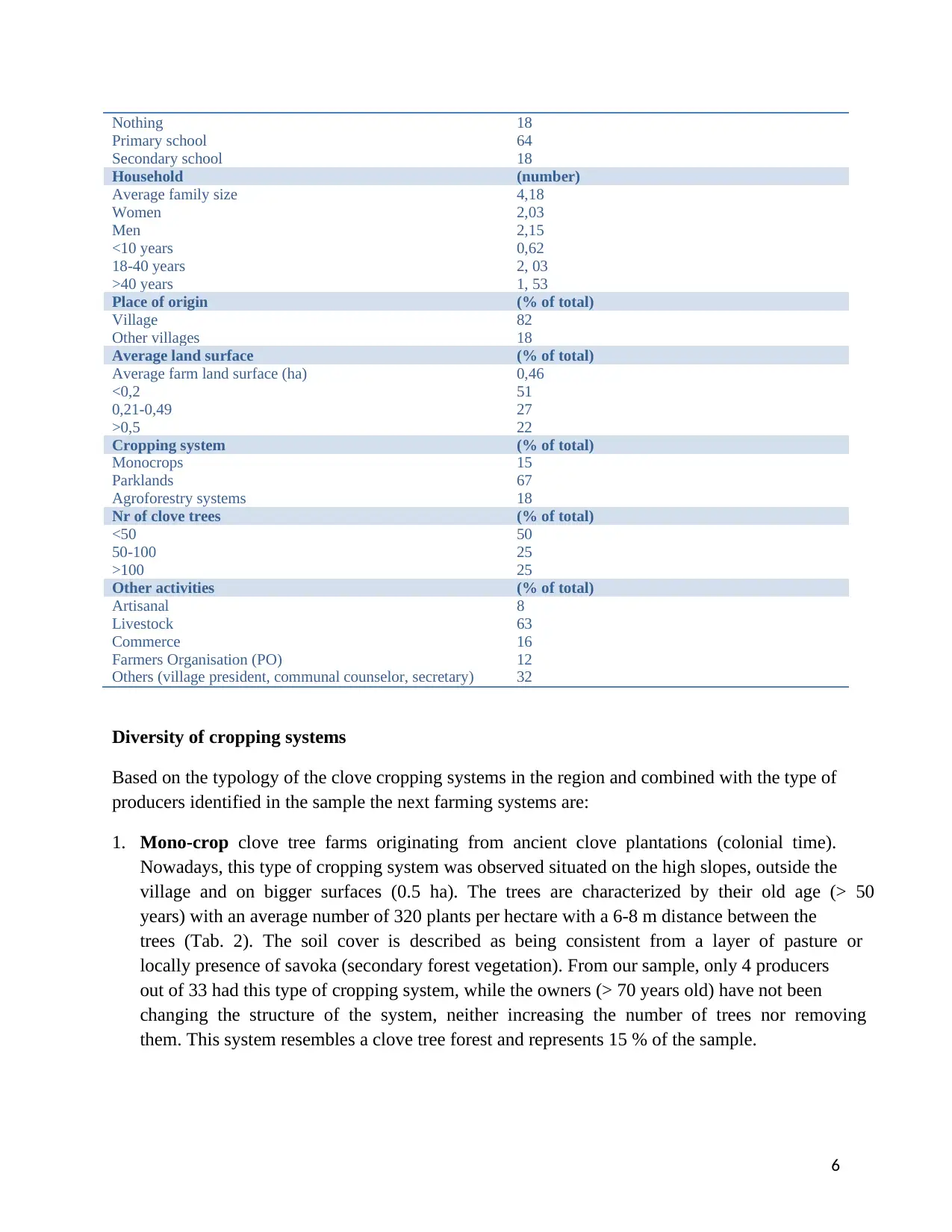
6
Nothing
Primary school
Secondary school
18
64
18
Household (number)
Average family size
Women
Men
<10 years
18-40 years
>40 years
4,18
2,03
2,15
0,62
2, 03
1, 53
Place of origin (% of total)
Village
Other villages
82
18
Average land surface (% of total)
Average farm land surface (ha)
<0,2
0,21-0,49
>0,5
0,46
51
27
22
Cropping system (% of total)
Monocrops
Parklands
Agroforestry systems
15
67
18
Nr of clove trees (% of total)
<50
50-100
>100
50
25
25
Other activities (% of total)
Artisanal
Livestock
Commerce
Farmers Organisation (PO)
Others (village president, communal counselor, secretary)
8
63
16
12
32
Diversity of cropping systems
Based on the typology of the clove cropping systems in the region and combined with the type of
producers identified in the sample the next farming systems are:
1. Mono-crop clove tree farms originating from ancient clove plantations (colonial time).
Nowadays, this type of cropping system was observed situated on the high slopes, outside the
village and on bigger surfaces (0.5 ha). The trees are characterized by their old age (> 50
years) with an average number of 320 plants per hectare with a 6-8 m distance between the
trees (Tab. 2). The soil cover is described as being consistent from a layer of pasture or
locally presence of savoka (secondary forest vegetation). From our sample, only 4 producers
out of 33 had this type of cropping system, while the owners (> 70 years old) have not been
changing the structure of the system, neither increasing the number of trees nor removing
them. This system resembles a clove tree forest and represents 15 % of the sample.
Nothing
Primary school
Secondary school
18
64
18
Household (number)
Average family size
Women
Men
<10 years
18-40 years
>40 years
4,18
2,03
2,15
0,62
2, 03
1, 53
Place of origin (% of total)
Village
Other villages
82
18
Average land surface (% of total)
Average farm land surface (ha)
<0,2
0,21-0,49
>0,5
0,46
51
27
22
Cropping system (% of total)
Monocrops
Parklands
Agroforestry systems
15
67
18
Nr of clove trees (% of total)
<50
50-100
>100
50
25
25
Other activities (% of total)
Artisanal
Livestock
Commerce
Farmers Organisation (PO)
Others (village president, communal counselor, secretary)
8
63
16
12
32
Diversity of cropping systems
Based on the typology of the clove cropping systems in the region and combined with the type of
producers identified in the sample the next farming systems are:
1. Mono-crop clove tree farms originating from ancient clove plantations (colonial time).
Nowadays, this type of cropping system was observed situated on the high slopes, outside the
village and on bigger surfaces (0.5 ha). The trees are characterized by their old age (> 50
years) with an average number of 320 plants per hectare with a 6-8 m distance between the
trees (Tab. 2). The soil cover is described as being consistent from a layer of pasture or
locally presence of savoka (secondary forest vegetation). From our sample, only 4 producers
out of 33 had this type of cropping system, while the owners (> 70 years old) have not been
changing the structure of the system, neither increasing the number of trees nor removing
them. This system resembles a clove tree forest and represents 15 % of the sample.
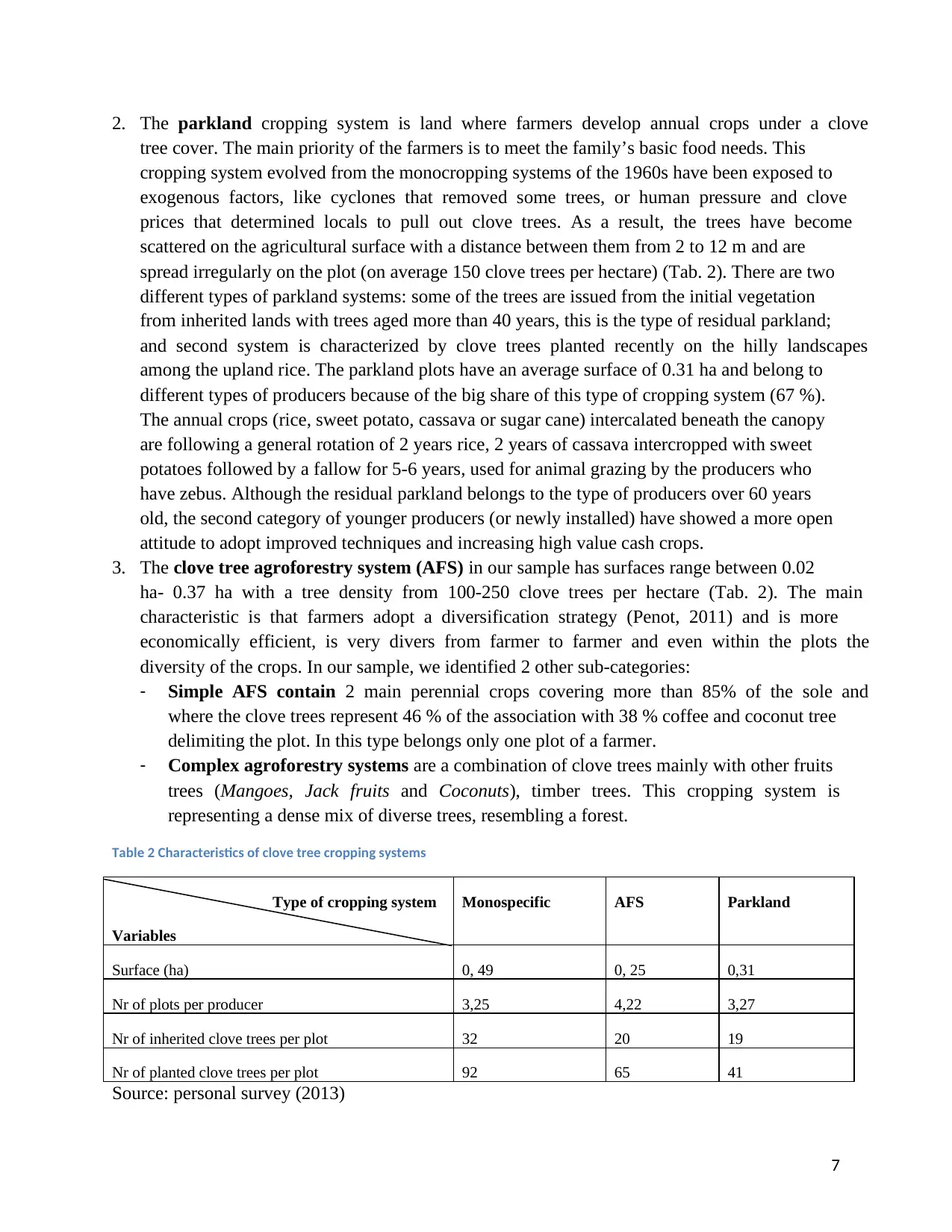
7
2. The parkland cropping system is land where farmers develop annual crops under a clove
tree cover. The main priority of the farmers is to meet the family’s basic food needs. This
cropping system evolved from the monocropping systems of the 1960s have been exposed to
exogenous factors, like cyclones that removed some trees, or human pressure and clove
prices that determined locals to pull out clove trees. As a result, the trees have become
scattered on the agricultural surface with a distance between them from 2 to 12 m and are
spread irregularly on the plot (on average 150 clove trees per hectare) (Tab. 2). There are two
different types of parkland systems: some of the trees are issued from the initial vegetation
from inherited lands with trees aged more than 40 years, this is the type of residual parkland;
and second system is characterized by clove trees planted recently on the hilly landscapes
among the upland rice. The parkland plots have an average surface of 0.31 ha and belong to
different types of producers because of the big share of this type of cropping system (67 %).
The annual crops (rice, sweet potato, cassava or sugar cane) intercalated beneath the canopy
are following a general rotation of 2 years rice, 2 years of cassava intercropped with sweet
potatoes followed by a fallow for 5-6 years, used for animal grazing by the producers who
have zebus. Although the residual parkland belongs to the type of producers over 60 years
old, the second category of younger producers (or newly installed) have showed a more open
attitude to adopt improved techniques and increasing high value cash crops.
3. The clove tree agroforestry system (AFS) in our sample has surfaces range between 0.02
ha- 0.37 ha with a tree density from 100-250 clove trees per hectare (Tab. 2). The main
characteristic is that farmers adopt a diversification strategy (Penot, 2011) and is more
economically efficient, is very divers from farmer to farmer and even within the plots the
diversity of the crops. In our sample, we identified 2 other sub-categories:
- Simple AFS contain 2 main perennial crops covering more than 85% of the sole and
where the clove trees represent 46 % of the association with 38 % coffee and coconut tree
delimiting the plot. In this type belongs only one plot of a farmer.
- Complex agroforestry systems are a combination of clove trees mainly with other fruits
trees (Mangoes, Jack fruits and Coconuts), timber trees. This cropping system is
representing a dense mix of diverse trees, resembling a forest.
Table 2 Characteristics of clove tree cropping systems
Type of cropping system
Variables
Monospecific AFS Parkland
Surface (ha) 0, 49 0, 25 0,31
Nr of plots per producer 3,25 4,22 3,27
Nr of inherited clove trees per plot 32 20 19
Nr of planted clove trees per plot 92 65 41
Source: personal survey (2013)
2. The parkland cropping system is land where farmers develop annual crops under a clove
tree cover. The main priority of the farmers is to meet the family’s basic food needs. This
cropping system evolved from the monocropping systems of the 1960s have been exposed to
exogenous factors, like cyclones that removed some trees, or human pressure and clove
prices that determined locals to pull out clove trees. As a result, the trees have become
scattered on the agricultural surface with a distance between them from 2 to 12 m and are
spread irregularly on the plot (on average 150 clove trees per hectare) (Tab. 2). There are two
different types of parkland systems: some of the trees are issued from the initial vegetation
from inherited lands with trees aged more than 40 years, this is the type of residual parkland;
and second system is characterized by clove trees planted recently on the hilly landscapes
among the upland rice. The parkland plots have an average surface of 0.31 ha and belong to
different types of producers because of the big share of this type of cropping system (67 %).
The annual crops (rice, sweet potato, cassava or sugar cane) intercalated beneath the canopy
are following a general rotation of 2 years rice, 2 years of cassava intercropped with sweet
potatoes followed by a fallow for 5-6 years, used for animal grazing by the producers who
have zebus. Although the residual parkland belongs to the type of producers over 60 years
old, the second category of younger producers (or newly installed) have showed a more open
attitude to adopt improved techniques and increasing high value cash crops.
3. The clove tree agroforestry system (AFS) in our sample has surfaces range between 0.02
ha- 0.37 ha with a tree density from 100-250 clove trees per hectare (Tab. 2). The main
characteristic is that farmers adopt a diversification strategy (Penot, 2011) and is more
economically efficient, is very divers from farmer to farmer and even within the plots the
diversity of the crops. In our sample, we identified 2 other sub-categories:
- Simple AFS contain 2 main perennial crops covering more than 85% of the sole and
where the clove trees represent 46 % of the association with 38 % coffee and coconut tree
delimiting the plot. In this type belongs only one plot of a farmer.
- Complex agroforestry systems are a combination of clove trees mainly with other fruits
trees (Mangoes, Jack fruits and Coconuts), timber trees. This cropping system is
representing a dense mix of diverse trees, resembling a forest.
Table 2 Characteristics of clove tree cropping systems
Type of cropping system
Variables
Monospecific AFS Parkland
Surface (ha) 0, 49 0, 25 0,31
Nr of plots per producer 3,25 4,22 3,27
Nr of inherited clove trees per plot 32 20 19
Nr of planted clove trees per plot 92 65 41
Source: personal survey (2013)
Paraphrase This Document
Need a fresh take? Get an instant paraphrase of this document with our AI Paraphraser
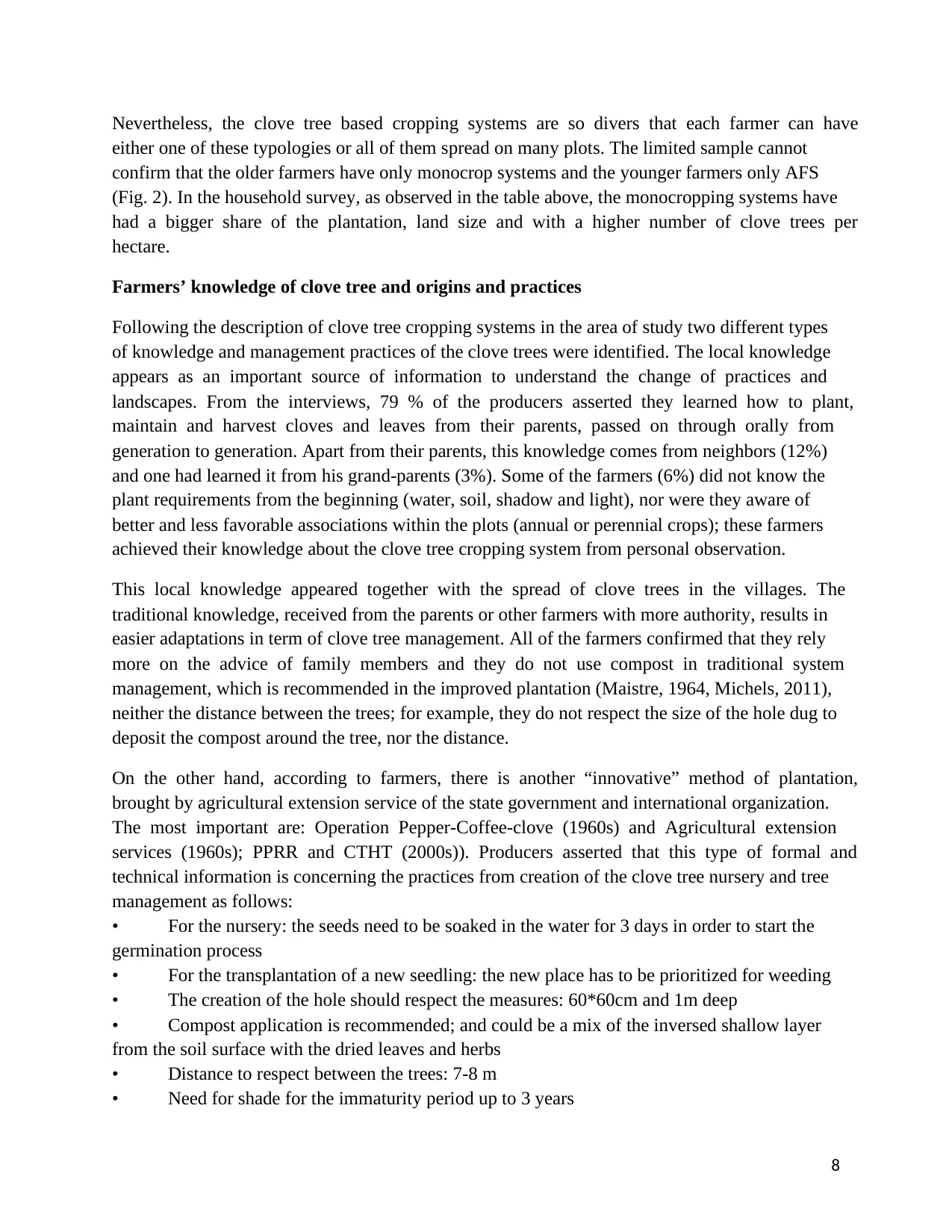
8
Nevertheless, the clove tree based cropping systems are so divers that each farmer can have
either one of these typologies or all of them spread on many plots. The limited sample cannot
confirm that the older farmers have only monocrop systems and the younger farmers only AFS
(Fig. 2). In the household survey, as observed in the table above, the monocropping systems have
had a bigger share of the plantation, land size and with a higher number of clove trees per
hectare.
Farmers’ knowledge of clove tree and origins and practices
Following the description of clove tree cropping systems in the area of study two different types
of knowledge and management practices of the clove trees were identified. The local knowledge
appears as an important source of information to understand the change of practices and
landscapes. From the interviews, 79 % of the producers asserted they learned how to plant,
maintain and harvest cloves and leaves from their parents, passed on through orally from
generation to generation. Apart from their parents, this knowledge comes from neighbors (12%)
and one had learned it from his grand-parents (3%). Some of the farmers (6%) did not know the
plant requirements from the beginning (water, soil, shadow and light), nor were they aware of
better and less favorable associations within the plots (annual or perennial crops); these farmers
achieved their knowledge about the clove tree cropping system from personal observation.
This local knowledge appeared together with the spread of clove trees in the villages. The
traditional knowledge, received from the parents or other farmers with more authority, results in
easier adaptations in term of clove tree management. All of the farmers confirmed that they rely
more on the advice of family members and they do not use compost in traditional system
management, which is recommended in the improved plantation (Maistre, 1964, Michels, 2011),
neither the distance between the trees; for example, they do not respect the size of the hole dug to
deposit the compost around the tree, nor the distance.
On the other hand, according to farmers, there is another “innovative” method of plantation,
brought by agricultural extension service of the state government and international organization.
The most important are: Operation Pepper-Coffee-clove (1960s) and Agricultural extension
services (1960s); PPRR and CTHT (2000s)). Producers asserted that this type of formal and
technical information is concerning the practices from creation of the clove tree nursery and tree
management as follows:
• For the nursery: the seeds need to be soaked in the water for 3 days in order to start the
germination process
• For the transplantation of a new seedling: the new place has to be prioritized for weeding
• The creation of the hole should respect the measures: 60*60cm and 1m deep
• Compost application is recommended; and could be a mix of the inversed shallow layer
from the soil surface with the dried leaves and herbs
• Distance to respect between the trees: 7-8 m
• Need for shade for the immaturity period up to 3 years
Nevertheless, the clove tree based cropping systems are so divers that each farmer can have
either one of these typologies or all of them spread on many plots. The limited sample cannot
confirm that the older farmers have only monocrop systems and the younger farmers only AFS
(Fig. 2). In the household survey, as observed in the table above, the monocropping systems have
had a bigger share of the plantation, land size and with a higher number of clove trees per
hectare.
Farmers’ knowledge of clove tree and origins and practices
Following the description of clove tree cropping systems in the area of study two different types
of knowledge and management practices of the clove trees were identified. The local knowledge
appears as an important source of information to understand the change of practices and
landscapes. From the interviews, 79 % of the producers asserted they learned how to plant,
maintain and harvest cloves and leaves from their parents, passed on through orally from
generation to generation. Apart from their parents, this knowledge comes from neighbors (12%)
and one had learned it from his grand-parents (3%). Some of the farmers (6%) did not know the
plant requirements from the beginning (water, soil, shadow and light), nor were they aware of
better and less favorable associations within the plots (annual or perennial crops); these farmers
achieved their knowledge about the clove tree cropping system from personal observation.
This local knowledge appeared together with the spread of clove trees in the villages. The
traditional knowledge, received from the parents or other farmers with more authority, results in
easier adaptations in term of clove tree management. All of the farmers confirmed that they rely
more on the advice of family members and they do not use compost in traditional system
management, which is recommended in the improved plantation (Maistre, 1964, Michels, 2011),
neither the distance between the trees; for example, they do not respect the size of the hole dug to
deposit the compost around the tree, nor the distance.
On the other hand, according to farmers, there is another “innovative” method of plantation,
brought by agricultural extension service of the state government and international organization.
The most important are: Operation Pepper-Coffee-clove (1960s) and Agricultural extension
services (1960s); PPRR and CTHT (2000s)). Producers asserted that this type of formal and
technical information is concerning the practices from creation of the clove tree nursery and tree
management as follows:
• For the nursery: the seeds need to be soaked in the water for 3 days in order to start the
germination process
• For the transplantation of a new seedling: the new place has to be prioritized for weeding
• The creation of the hole should respect the measures: 60*60cm and 1m deep
• Compost application is recommended; and could be a mix of the inversed shallow layer
from the soil surface with the dried leaves and herbs
• Distance to respect between the trees: 7-8 m
• Need for shade for the immaturity period up to 3 years
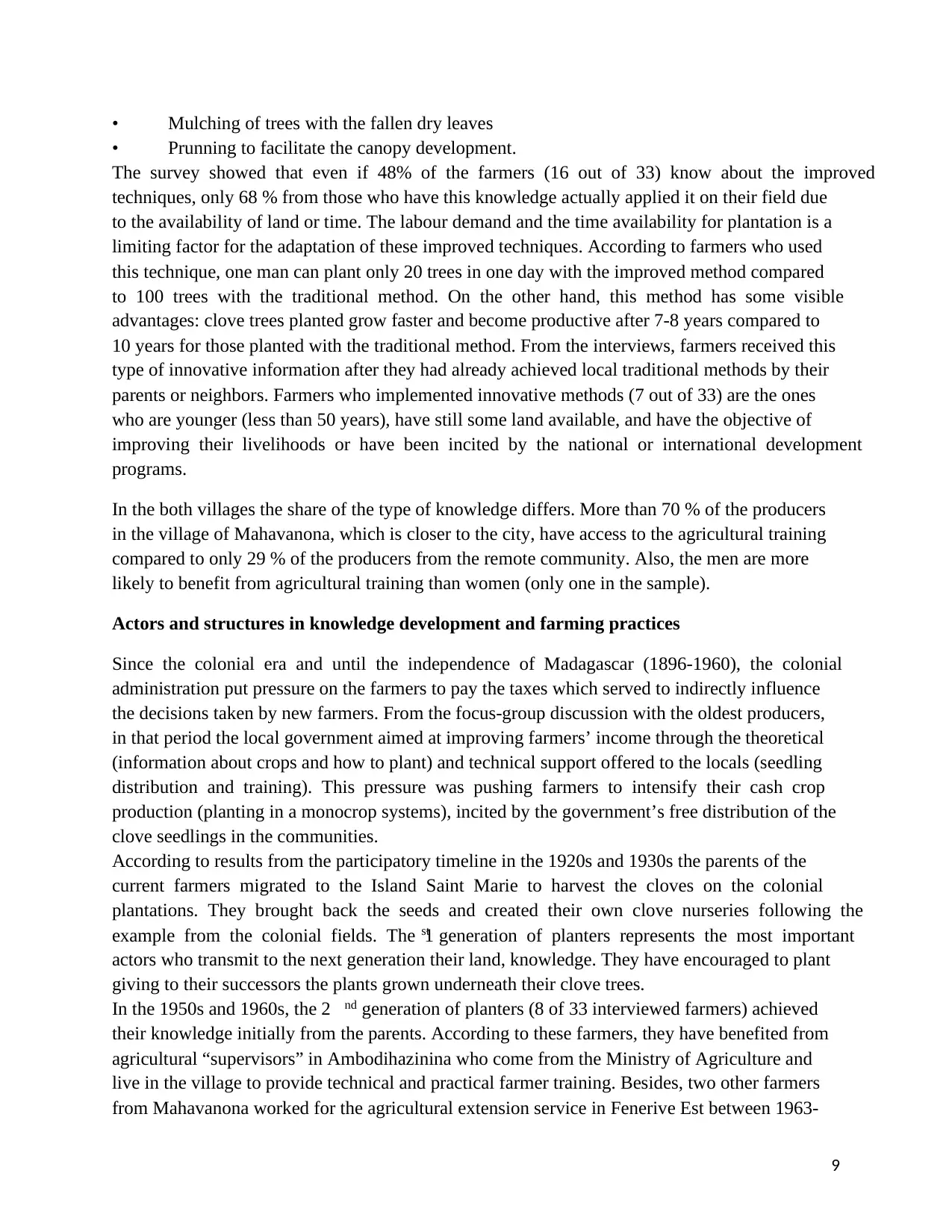
9
• Mulching of trees with the fallen dry leaves
• Prunning to facilitate the canopy development.
The survey showed that even if 48% of the farmers (16 out of 33) know about the improved
techniques, only 68 % from those who have this knowledge actually applied it on their field due
to the availability of land or time. The labour demand and the time availability for plantation is a
limiting factor for the adaptation of these improved techniques. According to farmers who used
this technique, one man can plant only 20 trees in one day with the improved method compared
to 100 trees with the traditional method. On the other hand, this method has some visible
advantages: clove trees planted grow faster and become productive after 7-8 years compared to
10 years for those planted with the traditional method. From the interviews, farmers received this
type of innovative information after they had already achieved local traditional methods by their
parents or neighbors. Farmers who implemented innovative methods (7 out of 33) are the ones
who are younger (less than 50 years), have still some land available, and have the objective of
improving their livelihoods or have been incited by the national or international development
programs.
In the both villages the share of the type of knowledge differs. More than 70 % of the producers
in the village of Mahavanona, which is closer to the city, have access to the agricultural training
compared to only 29 % of the producers from the remote community. Also, the men are more
likely to benefit from agricultural training than women (only one in the sample).
Actors and structures in knowledge development and farming practices
Since the colonial era and until the independence of Madagascar (1896-1960), the colonial
administration put pressure on the farmers to pay the taxes which served to indirectly influence
the decisions taken by new farmers. From the focus-group discussion with the oldest producers,
in that period the local government aimed at improving farmers’ income through the theoretical
(information about crops and how to plant) and technical support offered to the locals (seedling
distribution and training). This pressure was pushing farmers to intensify their cash crop
production (planting in a monocrop systems), incited by the government’s free distribution of the
clove seedlings in the communities.
According to results from the participatory timeline in the 1920s and 1930s the parents of the
current farmers migrated to the Island Saint Marie to harvest the cloves on the colonial
plantations. They brought back the seeds and created their own clove nurseries following the
example from the colonial fields. The 1st generation of planters represents the most important
actors who transmit to the next generation their land, knowledge. They have encouraged to plant
giving to their successors the plants grown underneath their clove trees.
In the 1950s and 1960s, the 2 nd generation of planters (8 of 33 interviewed farmers) achieved
their knowledge initially from the parents. According to these farmers, they have benefited from
agricultural “supervisors” in Ambodihazinina who come from the Ministry of Agriculture and
live in the village to provide technical and practical farmer training. Besides, two other farmers
from Mahavanona worked for the agricultural extension service in Fenerive Est between 1963-
• Mulching of trees with the fallen dry leaves
• Prunning to facilitate the canopy development.
The survey showed that even if 48% of the farmers (16 out of 33) know about the improved
techniques, only 68 % from those who have this knowledge actually applied it on their field due
to the availability of land or time. The labour demand and the time availability for plantation is a
limiting factor for the adaptation of these improved techniques. According to farmers who used
this technique, one man can plant only 20 trees in one day with the improved method compared
to 100 trees with the traditional method. On the other hand, this method has some visible
advantages: clove trees planted grow faster and become productive after 7-8 years compared to
10 years for those planted with the traditional method. From the interviews, farmers received this
type of innovative information after they had already achieved local traditional methods by their
parents or neighbors. Farmers who implemented innovative methods (7 out of 33) are the ones
who are younger (less than 50 years), have still some land available, and have the objective of
improving their livelihoods or have been incited by the national or international development
programs.
In the both villages the share of the type of knowledge differs. More than 70 % of the producers
in the village of Mahavanona, which is closer to the city, have access to the agricultural training
compared to only 29 % of the producers from the remote community. Also, the men are more
likely to benefit from agricultural training than women (only one in the sample).
Actors and structures in knowledge development and farming practices
Since the colonial era and until the independence of Madagascar (1896-1960), the colonial
administration put pressure on the farmers to pay the taxes which served to indirectly influence
the decisions taken by new farmers. From the focus-group discussion with the oldest producers,
in that period the local government aimed at improving farmers’ income through the theoretical
(information about crops and how to plant) and technical support offered to the locals (seedling
distribution and training). This pressure was pushing farmers to intensify their cash crop
production (planting in a monocrop systems), incited by the government’s free distribution of the
clove seedlings in the communities.
According to results from the participatory timeline in the 1920s and 1930s the parents of the
current farmers migrated to the Island Saint Marie to harvest the cloves on the colonial
plantations. They brought back the seeds and created their own clove nurseries following the
example from the colonial fields. The 1st generation of planters represents the most important
actors who transmit to the next generation their land, knowledge. They have encouraged to plant
giving to their successors the plants grown underneath their clove trees.
In the 1950s and 1960s, the 2 nd generation of planters (8 of 33 interviewed farmers) achieved
their knowledge initially from the parents. According to these farmers, they have benefited from
agricultural “supervisors” in Ambodihazinina who come from the Ministry of Agriculture and
live in the village to provide technical and practical farmer training. Besides, two other farmers
from Mahavanona worked for the agricultural extension service in Fenerive Est between 1963-
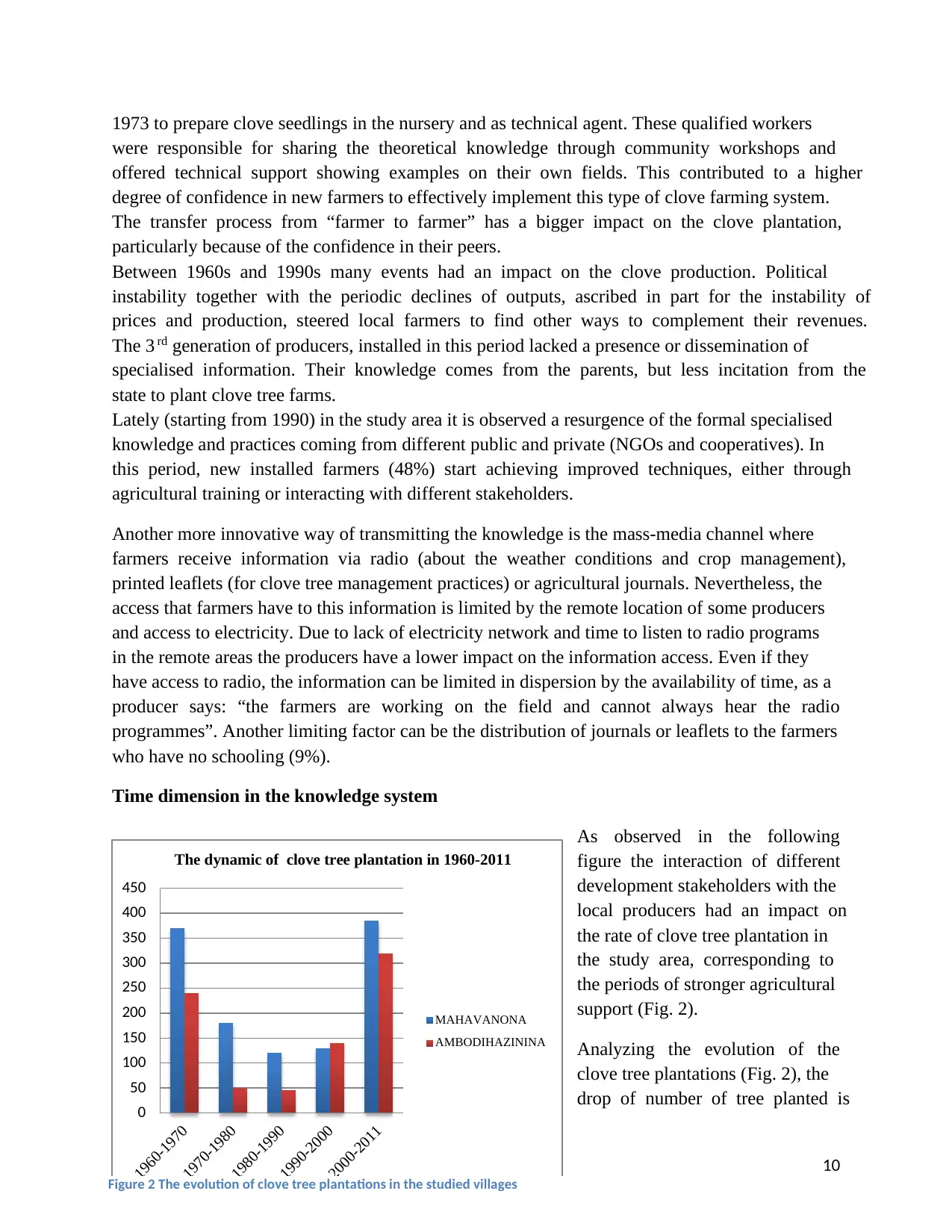
10
1973 to prepare clove seedlings in the nursery and as technical agent. These qualified workers
were responsible for sharing the theoretical knowledge through community workshops and
offered technical support showing examples on their own fields. This contributed to a higher
degree of confidence in new farmers to effectively implement this type of clove farming system.
The transfer process from “farmer to farmer” has a bigger impact on the clove plantation,
particularly because of the confidence in their peers.
Between 1960s and 1990s many events had an impact on the clove production. Political
instability together with the periodic declines of outputs, ascribed in part for the instability of
prices and production, steered local farmers to find other ways to complement their revenues.
The 3 rd generation of producers, installed in this period lacked a presence or dissemination of
specialised information. Their knowledge comes from the parents, but less incitation from the
state to plant clove tree farms.
Lately (starting from 1990) in the study area it is observed a resurgence of the formal specialised
knowledge and practices coming from different public and private (NGOs and cooperatives). In
this period, new installed farmers (48%) start achieving improved techniques, either through
agricultural training or interacting with different stakeholders.
Another more innovative way of transmitting the knowledge is the mass-media channel where
farmers receive information via radio (about the weather conditions and crop management),
printed leaflets (for clove tree management practices) or agricultural journals. Nevertheless, the
access that farmers have to this information is limited by the remote location of some producers
and access to electricity. Due to lack of electricity network and time to listen to radio programs
in the remote areas the producers have a lower impact on the information access. Even if they
have access to radio, the information can be limited in dispersion by the availability of time, as a
producer says: “the farmers are working on the field and cannot always hear the radio
programmes”. Another limiting factor can be the distribution of journals or leaflets to the farmers
who have no schooling (9%).
Time dimension in the knowledge system
As observed in the following
figure the interaction of different
development stakeholders with the
local producers had an impact on
the rate of clove tree plantation in
the study area, corresponding to
the periods of stronger agricultural
support (Fig. 2).
Analyzing the evolution of the
clove tree plantations (Fig. 2), the
drop of number of tree planted is
0
50
100
150
200
250
300
350
400
450
1960-1970
1970-1980
1980-1990
1990-2000
2000-2011
The dynamic of clove tree plantation in 1960-2011
MAHAVANONA
AMBODIHAZININA
Figure 2 The evolution of clove tree plantations in the studied villages
1973 to prepare clove seedlings in the nursery and as technical agent. These qualified workers
were responsible for sharing the theoretical knowledge through community workshops and
offered technical support showing examples on their own fields. This contributed to a higher
degree of confidence in new farmers to effectively implement this type of clove farming system.
The transfer process from “farmer to farmer” has a bigger impact on the clove plantation,
particularly because of the confidence in their peers.
Between 1960s and 1990s many events had an impact on the clove production. Political
instability together with the periodic declines of outputs, ascribed in part for the instability of
prices and production, steered local farmers to find other ways to complement their revenues.
The 3 rd generation of producers, installed in this period lacked a presence or dissemination of
specialised information. Their knowledge comes from the parents, but less incitation from the
state to plant clove tree farms.
Lately (starting from 1990) in the study area it is observed a resurgence of the formal specialised
knowledge and practices coming from different public and private (NGOs and cooperatives). In
this period, new installed farmers (48%) start achieving improved techniques, either through
agricultural training or interacting with different stakeholders.
Another more innovative way of transmitting the knowledge is the mass-media channel where
farmers receive information via radio (about the weather conditions and crop management),
printed leaflets (for clove tree management practices) or agricultural journals. Nevertheless, the
access that farmers have to this information is limited by the remote location of some producers
and access to electricity. Due to lack of electricity network and time to listen to radio programs
in the remote areas the producers have a lower impact on the information access. Even if they
have access to radio, the information can be limited in dispersion by the availability of time, as a
producer says: “the farmers are working on the field and cannot always hear the radio
programmes”. Another limiting factor can be the distribution of journals or leaflets to the farmers
who have no schooling (9%).
Time dimension in the knowledge system
As observed in the following
figure the interaction of different
development stakeholders with the
local producers had an impact on
the rate of clove tree plantation in
the study area, corresponding to
the periods of stronger agricultural
support (Fig. 2).
Analyzing the evolution of the
clove tree plantations (Fig. 2), the
drop of number of tree planted is
0
50
100
150
200
250
300
350
400
450
1960-1970
1970-1980
1980-1990
1990-2000
2000-2011
The dynamic of clove tree plantation in 1960-2011
MAHAVANONA
AMBODIHAZININA
Figure 2 The evolution of clove tree plantations in the studied villages
Secure Best Marks with AI Grader
Need help grading? Try our AI Grader for instant feedback on your assignments.
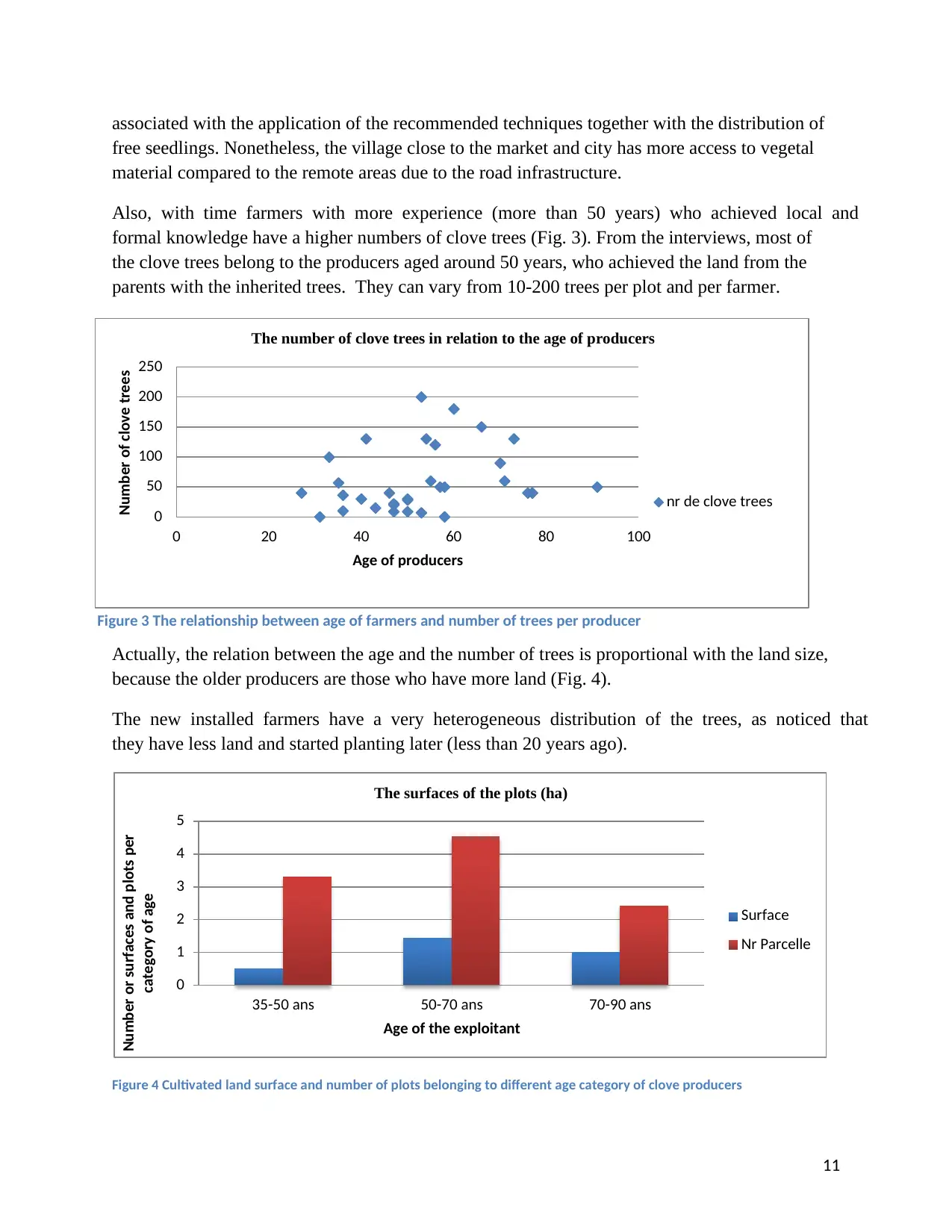
11
associated with the application of the recommended techniques together with the distribution of
free seedlings. Nonetheless, the village close to the market and city has more access to vegetal
material compared to the remote areas due to the road infrastructure.
Also, with time farmers with more experience (more than 50 years) who achieved local and
formal knowledge have a higher numbers of clove trees (Fig. 3). From the interviews, most of
the clove trees belong to the producers aged around 50 years, who achieved the land from the
parents with the inherited trees. They can vary from 10-200 trees per plot and per farmer.
Actually, the relation between the age and the number of trees is proportional with the land size,
because the older producers are those who have more land (Fig. 4).
The new installed farmers have a very heterogeneous distribution of the trees, as noticed that
they have less land and started planting later (less than 20 years ago).
Figure 4 Cultivated land surface and number of plots belonging to different age category of clove producers
0
1
2
3
4
5
35-50 ans 50-70 ans 70-90 ans
Number or surfaces and plots per
category of age
Age of the exploitant
The surfaces of the plots (ha)
Surface
Nr Parcelle
0
50
100
150
200
250
0 20 40 60 80 100
Number of clove trees
Age of producers
The number of clove trees in relation to the age of producers
nr de clove trees
Figure 3 The relationship between age of farmers and number of trees per producer
associated with the application of the recommended techniques together with the distribution of
free seedlings. Nonetheless, the village close to the market and city has more access to vegetal
material compared to the remote areas due to the road infrastructure.
Also, with time farmers with more experience (more than 50 years) who achieved local and
formal knowledge have a higher numbers of clove trees (Fig. 3). From the interviews, most of
the clove trees belong to the producers aged around 50 years, who achieved the land from the
parents with the inherited trees. They can vary from 10-200 trees per plot and per farmer.
Actually, the relation between the age and the number of trees is proportional with the land size,
because the older producers are those who have more land (Fig. 4).
The new installed farmers have a very heterogeneous distribution of the trees, as noticed that
they have less land and started planting later (less than 20 years ago).
Figure 4 Cultivated land surface and number of plots belonging to different age category of clove producers
0
1
2
3
4
5
35-50 ans 50-70 ans 70-90 ans
Number or surfaces and plots per
category of age
Age of the exploitant
The surfaces of the plots (ha)
Surface
Nr Parcelle
0
50
100
150
200
250
0 20 40 60 80 100
Number of clove trees
Age of producers
The number of clove trees in relation to the age of producers
nr de clove trees
Figure 3 The relationship between age of farmers and number of trees per producer

12
Nevertheless, the age of the producers is not always a key indicator for the knowledge. The
interaction with agricultural extension service is determinant for the type of knowledge. But the
land ownership and surface have the most important role in the choice of the cropping systems.
Historical evolution of tree diversity in clove systems
From the free walks on the fields it was observed in some AFS the association of clove and
coffee trees in sequential arrangements within the plots, issued from the same period as
monocropping systems (colonial period). Coffee (C. Canephora) was introduced in the region
before clove trees (1900s) (Ramilison, 1985) as participants of the timeline exercise confirmed.
Monocropped plantations of coffee were damaged by a fungus attack in the early 1930s by
« Hemileia vastarix » (Ramilison, 1985). Old coffee trees were replaced with clove trees.
Though, in the households’ surveys the AFS (18% of our sample) appear to be more recent
cropping system from the period that farmers started to diversify after 1980s.
From the tree inventories clove tree agroforests have many tree species in common with 8
predominant species. The closer the AFS to the dwelling the composition of species is more
divers, with more fruits tree species. The number of cash crops is increasing with the distance
from the village. Tree diversity is higher in the villages that have access to the market. This fact
is indicating that socio-economic and ecological factors influence the composition of clove tree
AFSs. Trees with edible products are most planted in the clove agroforestry systems (Fig. 5) as
the Malagasy farmers rely on them to complement family’s food production. Exotic fruits trees
(Tab. 3) are the most planted or retained trees (planted from the parents or grand-parents time)
after clove trees. The density of timber trees decreased as the clove trees are maturing.
Figure 5 Trees distribution and share of cloves in AFS
0%
10%
20%
30%
40%
50%
60%
70%
80%
90%
100%
AFS 1 AFS 2 AFS 3 AFS 4 AFS 5 AFS 6
Clove tree distribution in agroforestry systems Banane
Ravenala
Grevilea
Arongana
Albizzia
Bread fruit
Avocado
Coconut
Corosol
Jack fruit
Mango
Ramboutan
Litchi
Canelle
Coffee
Clove
Nevertheless, the age of the producers is not always a key indicator for the knowledge. The
interaction with agricultural extension service is determinant for the type of knowledge. But the
land ownership and surface have the most important role in the choice of the cropping systems.
Historical evolution of tree diversity in clove systems
From the free walks on the fields it was observed in some AFS the association of clove and
coffee trees in sequential arrangements within the plots, issued from the same period as
monocropping systems (colonial period). Coffee (C. Canephora) was introduced in the region
before clove trees (1900s) (Ramilison, 1985) as participants of the timeline exercise confirmed.
Monocropped plantations of coffee were damaged by a fungus attack in the early 1930s by
« Hemileia vastarix » (Ramilison, 1985). Old coffee trees were replaced with clove trees.
Though, in the households’ surveys the AFS (18% of our sample) appear to be more recent
cropping system from the period that farmers started to diversify after 1980s.
From the tree inventories clove tree agroforests have many tree species in common with 8
predominant species. The closer the AFS to the dwelling the composition of species is more
divers, with more fruits tree species. The number of cash crops is increasing with the distance
from the village. Tree diversity is higher in the villages that have access to the market. This fact
is indicating that socio-economic and ecological factors influence the composition of clove tree
AFSs. Trees with edible products are most planted in the clove agroforestry systems (Fig. 5) as
the Malagasy farmers rely on them to complement family’s food production. Exotic fruits trees
(Tab. 3) are the most planted or retained trees (planted from the parents or grand-parents time)
after clove trees. The density of timber trees decreased as the clove trees are maturing.
Figure 5 Trees distribution and share of cloves in AFS
0%
10%
20%
30%
40%
50%
60%
70%
80%
90%
100%
AFS 1 AFS 2 AFS 3 AFS 4 AFS 5 AFS 6
Clove tree distribution in agroforestry systems Banane
Ravenala
Grevilea
Arongana
Albizzia
Bread fruit
Avocado
Coconut
Corosol
Jack fruit
Mango
Ramboutan
Litchi
Canelle
Coffee
Clove
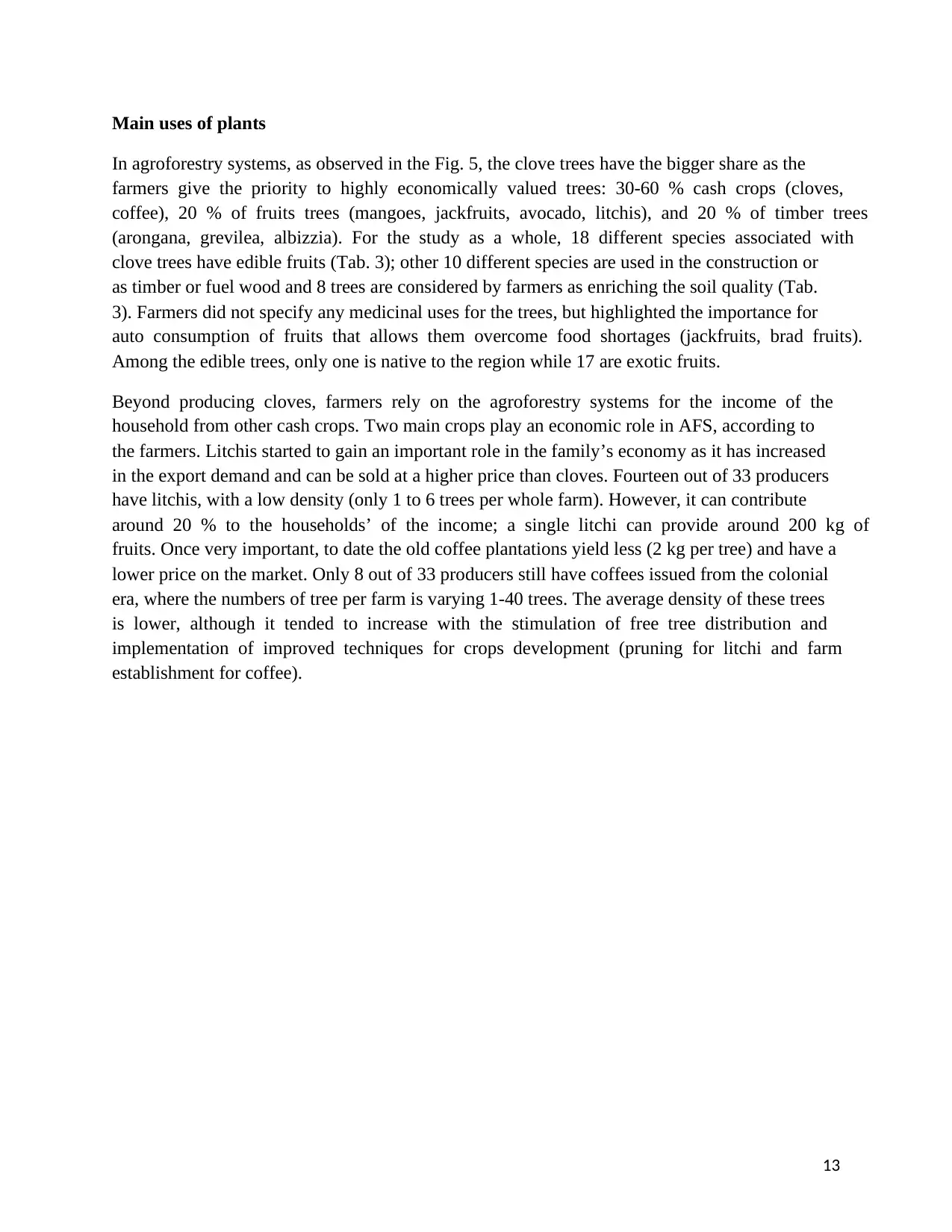
13
Main uses of plants
In agroforestry systems, as observed in the Fig. 5, the clove trees have the bigger share as the
farmers give the priority to highly economically valued trees: 30-60 % cash crops (cloves,
coffee), 20 % of fruits trees (mangoes, jackfruits, avocado, litchis), and 20 % of timber trees
(arongana, grevilea, albizzia). For the study as a whole, 18 different species associated with
clove trees have edible fruits (Tab. 3); other 10 different species are used in the construction or
as timber or fuel wood and 8 trees are considered by farmers as enriching the soil quality (Tab.
3). Farmers did not specify any medicinal uses for the trees, but highlighted the importance for
auto consumption of fruits that allows them overcome food shortages (jackfruits, brad fruits).
Among the edible trees, only one is native to the region while 17 are exotic fruits.
Beyond producing cloves, farmers rely on the agroforestry systems for the income of the
household from other cash crops. Two main crops play an economic role in AFS, according to
the farmers. Litchis started to gain an important role in the family’s economy as it has increased
in the export demand and can be sold at a higher price than cloves. Fourteen out of 33 producers
have litchis, with a low density (only 1 to 6 trees per whole farm). However, it can contribute
around 20 % to the households’ of the income; a single litchi can provide around 200 kg of
fruits. Once very important, to date the old coffee plantations yield less (2 kg per tree) and have a
lower price on the market. Only 8 out of 33 producers still have coffees issued from the colonial
era, where the numbers of tree per farm is varying 1-40 trees. The average density of these trees
is lower, although it tended to increase with the stimulation of free tree distribution and
implementation of improved techniques for crops development (pruning for litchi and farm
establishment for coffee).
Main uses of plants
In agroforestry systems, as observed in the Fig. 5, the clove trees have the bigger share as the
farmers give the priority to highly economically valued trees: 30-60 % cash crops (cloves,
coffee), 20 % of fruits trees (mangoes, jackfruits, avocado, litchis), and 20 % of timber trees
(arongana, grevilea, albizzia). For the study as a whole, 18 different species associated with
clove trees have edible fruits (Tab. 3); other 10 different species are used in the construction or
as timber or fuel wood and 8 trees are considered by farmers as enriching the soil quality (Tab.
3). Farmers did not specify any medicinal uses for the trees, but highlighted the importance for
auto consumption of fruits that allows them overcome food shortages (jackfruits, brad fruits).
Among the edible trees, only one is native to the region while 17 are exotic fruits.
Beyond producing cloves, farmers rely on the agroforestry systems for the income of the
household from other cash crops. Two main crops play an economic role in AFS, according to
the farmers. Litchis started to gain an important role in the family’s economy as it has increased
in the export demand and can be sold at a higher price than cloves. Fourteen out of 33 producers
have litchis, with a low density (only 1 to 6 trees per whole farm). However, it can contribute
around 20 % to the households’ of the income; a single litchi can provide around 200 kg of
fruits. Once very important, to date the old coffee plantations yield less (2 kg per tree) and have a
lower price on the market. Only 8 out of 33 producers still have coffees issued from the colonial
era, where the numbers of tree per farm is varying 1-40 trees. The average density of these trees
is lower, although it tended to increase with the stimulation of free tree distribution and
implementation of improved techniques for crops development (pruning for litchi and farm
establishment for coffee).
Paraphrase This Document
Need a fresh take? Get an instant paraphrase of this document with our AI Paraphraser
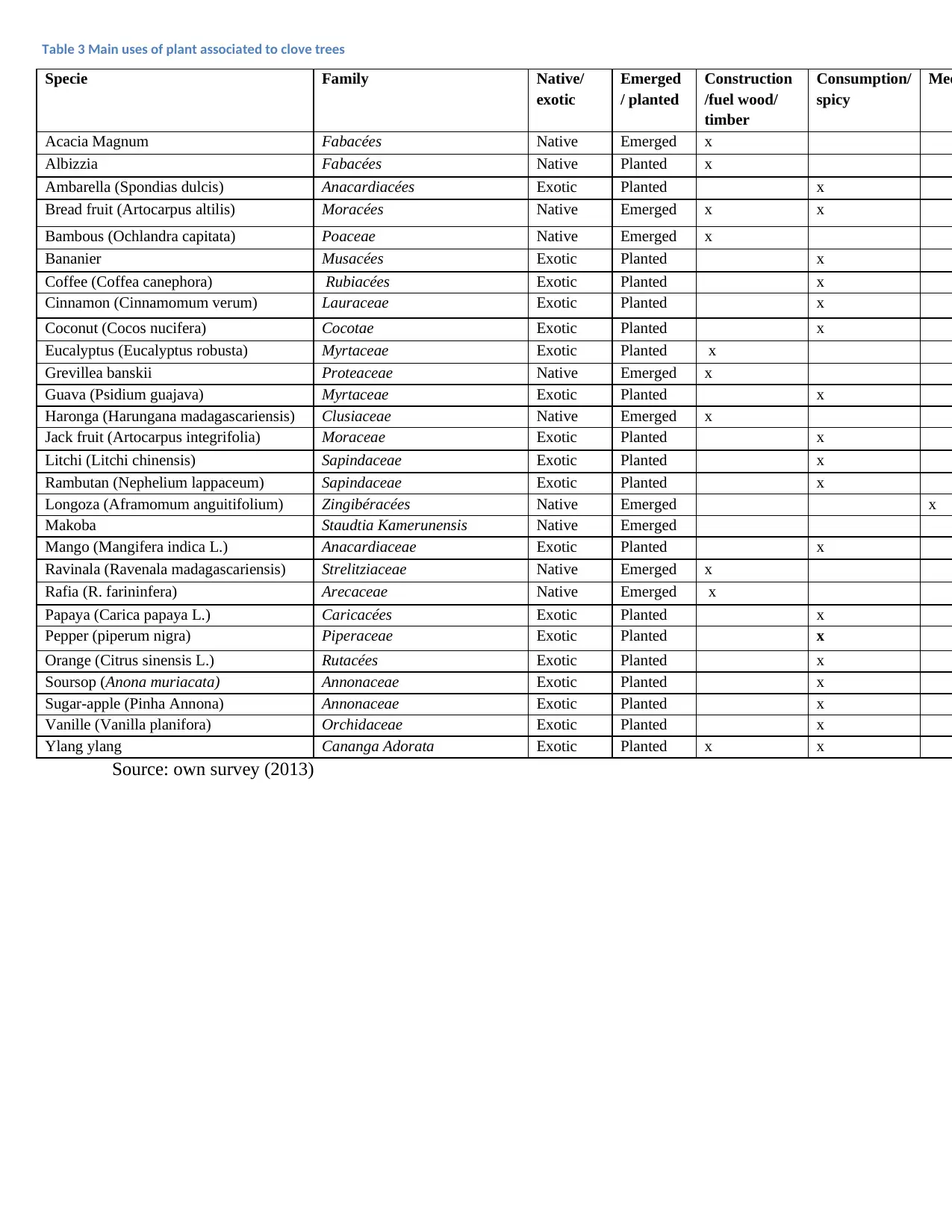
Source: own survey (2013)
Specie Family Native/
exotic
Emerged
/ planted
Construction
/fuel wood/
timber
Consumption/
spicy
Med
Acacia Magnum Fabacées Native Emerged x
Albizzia Fabacées Native Planted x
Ambarella (Spondias dulcis) Anacardiacées Exotic Planted x
Bread fruit (Artocarpus altilis) Moracées Native Emerged x x
Bambous (Ochlandra capitata) Poaceae Native Emerged x
Bananier Musacées Exotic Planted x
Coffee (Coffea canephora) Rubiacées Exotic Planted x
Cinnamon (Cinnamomum verum) Lauraceae Exotic Planted x
Coconut (Cocos nucifera) Cocotae Exotic Planted x
Eucalyptus (Eucalyptus robusta) Myrtaceae Exotic Planted x
Grevillea banskii Proteaceae Native Emerged x
Guava (Psidium guajava) Myrtaceae Exotic Planted x
Haronga (Harungana madagascariensis) Clusiaceae Native Emerged x
Jack fruit (Artocarpus integrifolia) Moraceae Exotic Planted x
Litchi (Litchi chinensis) Sapindaceae Exotic Planted x
Rambutan (Nephelium lappaceum) Sapindaceae Exotic Planted x
Longoza (Aframomum anguitifolium) Zingibéracées Native Emerged x
Makoba Staudtia Kamerunensis Native Emerged
Mango (Mangifera indica L.) Anacardiaceae Exotic Planted x
Ravinala (Ravenala madagascariensis) Strelitziaceae Native Emerged x
Rafia (R. farininfera) Arecaceae Native Emerged x
Papaya (Carica papaya L.) Caricacées Exotic Planted x
Pepper (piperum nigra) Piperaceae Exotic Planted x
Orange (Citrus sinensis L.) Rutacées Exotic Planted x
Soursop (Anona muriacata) Annonaceae Exotic Planted x
Sugar-apple (Pinha Annona) Annonaceae Exotic Planted x
Vanille (Vanilla planifora) Orchidaceae Exotic Planted x
Ylang ylang Cananga Adorata Exotic Planted x x
Table 3 Main uses of plant associated to clove trees
Specie Family Native/
exotic
Emerged
/ planted
Construction
/fuel wood/
timber
Consumption/
spicy
Med
Acacia Magnum Fabacées Native Emerged x
Albizzia Fabacées Native Planted x
Ambarella (Spondias dulcis) Anacardiacées Exotic Planted x
Bread fruit (Artocarpus altilis) Moracées Native Emerged x x
Bambous (Ochlandra capitata) Poaceae Native Emerged x
Bananier Musacées Exotic Planted x
Coffee (Coffea canephora) Rubiacées Exotic Planted x
Cinnamon (Cinnamomum verum) Lauraceae Exotic Planted x
Coconut (Cocos nucifera) Cocotae Exotic Planted x
Eucalyptus (Eucalyptus robusta) Myrtaceae Exotic Planted x
Grevillea banskii Proteaceae Native Emerged x
Guava (Psidium guajava) Myrtaceae Exotic Planted x
Haronga (Harungana madagascariensis) Clusiaceae Native Emerged x
Jack fruit (Artocarpus integrifolia) Moraceae Exotic Planted x
Litchi (Litchi chinensis) Sapindaceae Exotic Planted x
Rambutan (Nephelium lappaceum) Sapindaceae Exotic Planted x
Longoza (Aframomum anguitifolium) Zingibéracées Native Emerged x
Makoba Staudtia Kamerunensis Native Emerged
Mango (Mangifera indica L.) Anacardiaceae Exotic Planted x
Ravinala (Ravenala madagascariensis) Strelitziaceae Native Emerged x
Rafia (R. farininfera) Arecaceae Native Emerged x
Papaya (Carica papaya L.) Caricacées Exotic Planted x
Pepper (piperum nigra) Piperaceae Exotic Planted x
Orange (Citrus sinensis L.) Rutacées Exotic Planted x
Soursop (Anona muriacata) Annonaceae Exotic Planted x
Sugar-apple (Pinha Annona) Annonaceae Exotic Planted x
Vanille (Vanilla planifora) Orchidaceae Exotic Planted x
Ylang ylang Cananga Adorata Exotic Planted x x
Table 3 Main uses of plant associated to clove trees
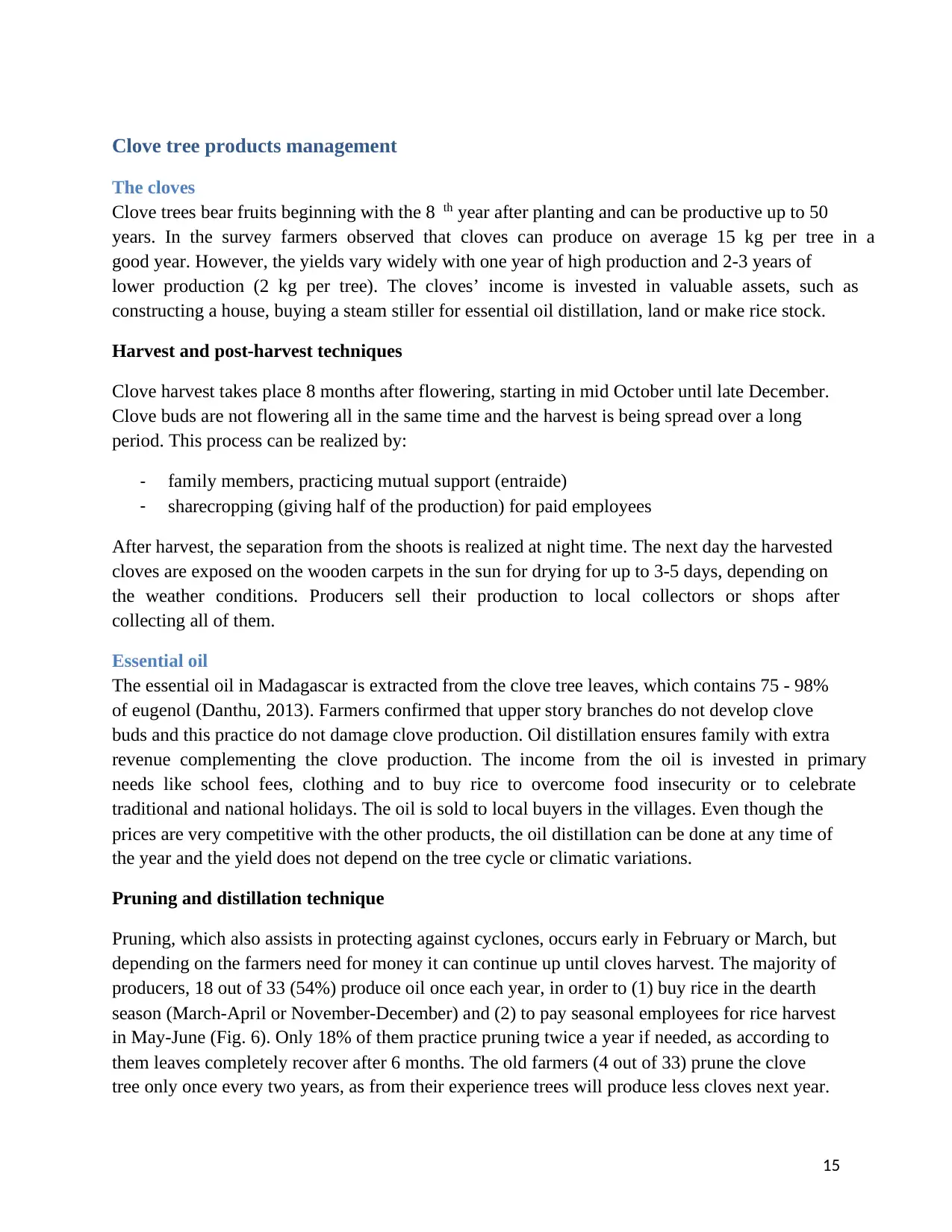
15
Clove tree products management
The cloves
Clove trees bear fruits beginning with the 8 th year after planting and can be productive up to 50
years. In the survey farmers observed that cloves can produce on average 15 kg per tree in a
good year. However, the yields vary widely with one year of high production and 2-3 years of
lower production (2 kg per tree). The cloves’ income is invested in valuable assets, such as
constructing a house, buying a steam stiller for essential oil distillation, land or make rice stock.
Harvest and post-harvest techniques
Clove harvest takes place 8 months after flowering, starting in mid October until late December.
Clove buds are not flowering all in the same time and the harvest is being spread over a long
period. This process can be realized by:
- family members, practicing mutual support (entraide)
- sharecropping (giving half of the production) for paid employees
After harvest, the separation from the shoots is realized at night time. The next day the harvested
cloves are exposed on the wooden carpets in the sun for drying for up to 3-5 days, depending on
the weather conditions. Producers sell their production to local collectors or shops after
collecting all of them.
Essential oil
The essential oil in Madagascar is extracted from the clove tree leaves, which contains 75 - 98%
of eugenol (Danthu, 2013). Farmers confirmed that upper story branches do not develop clove
buds and this practice do not damage clove production. Oil distillation ensures family with extra
revenue complementing the clove production. The income from the oil is invested in primary
needs like school fees, clothing and to buy rice to overcome food insecurity or to celebrate
traditional and national holidays. The oil is sold to local buyers in the villages. Even though the
prices are very competitive with the other products, the oil distillation can be done at any time of
the year and the yield does not depend on the tree cycle or climatic variations.
Pruning and distillation technique
Pruning, which also assists in protecting against cyclones, occurs early in February or March, but
depending on the farmers need for money it can continue up until cloves harvest. The majority of
producers, 18 out of 33 (54%) produce oil once each year, in order to (1) buy rice in the dearth
season (March-April or November-December) and (2) to pay seasonal employees for rice harvest
in May-June (Fig. 6). Only 18% of them practice pruning twice a year if needed, as according to
them leaves completely recover after 6 months. The old farmers (4 out of 33) prune the clove
tree only once every two years, as from their experience trees will produce less cloves next year.
Clove tree products management
The cloves
Clove trees bear fruits beginning with the 8 th year after planting and can be productive up to 50
years. In the survey farmers observed that cloves can produce on average 15 kg per tree in a
good year. However, the yields vary widely with one year of high production and 2-3 years of
lower production (2 kg per tree). The cloves’ income is invested in valuable assets, such as
constructing a house, buying a steam stiller for essential oil distillation, land or make rice stock.
Harvest and post-harvest techniques
Clove harvest takes place 8 months after flowering, starting in mid October until late December.
Clove buds are not flowering all in the same time and the harvest is being spread over a long
period. This process can be realized by:
- family members, practicing mutual support (entraide)
- sharecropping (giving half of the production) for paid employees
After harvest, the separation from the shoots is realized at night time. The next day the harvested
cloves are exposed on the wooden carpets in the sun for drying for up to 3-5 days, depending on
the weather conditions. Producers sell their production to local collectors or shops after
collecting all of them.
Essential oil
The essential oil in Madagascar is extracted from the clove tree leaves, which contains 75 - 98%
of eugenol (Danthu, 2013). Farmers confirmed that upper story branches do not develop clove
buds and this practice do not damage clove production. Oil distillation ensures family with extra
revenue complementing the clove production. The income from the oil is invested in primary
needs like school fees, clothing and to buy rice to overcome food insecurity or to celebrate
traditional and national holidays. The oil is sold to local buyers in the villages. Even though the
prices are very competitive with the other products, the oil distillation can be done at any time of
the year and the yield does not depend on the tree cycle or climatic variations.
Pruning and distillation technique
Pruning, which also assists in protecting against cyclones, occurs early in February or March, but
depending on the farmers need for money it can continue up until cloves harvest. The majority of
producers, 18 out of 33 (54%) produce oil once each year, in order to (1) buy rice in the dearth
season (March-April or November-December) and (2) to pay seasonal employees for rice harvest
in May-June (Fig. 6). Only 18% of them practice pruning twice a year if needed, as according to
them leaves completely recover after 6 months. The old farmers (4 out of 33) prune the clove
tree only once every two years, as from their experience trees will produce less cloves next year.

16
Figure 6 The number of farmers that produce oil each month
The distillation is realized in steam stiller for 24h. Usually the well-off farmers in the community
are the owners of this equipment, while producers who rent it are paying by giving 1/10 l of
distilled essential oil. There are 2 steams stiller in Mahavanona and 5 in Ambodihazinina.
Preference for clove products and their complementarities
The preference matrix realized in Mahavanona and focus group discussion permitted to identify
the preferences for the clove tree products. All the farmers specified that they prefer the cloves
because of the facility of harvest (by children, women and older persons) and rate of return. On
the other hand the pruning and distillation techniques are longer and demand hard working force
(only young men can do it: branches have to be cut, transported and steamed). The timber is
collected by men, but only in the conditions of dead tree and used for steam stiller or firewood.
In terms of storage, farmers can stock the cloves and wait for a better price.
However, the doubt and instability of the price of cloves changes farmers’ attitude and triggers
them to choose a risk management strategy, means to prune more branches for oil distillation.
This in turn can have some negatives impacts on the clove buds production as the irrational
pruning and overdoing the technique can remove some productive buds or even impede the
future yields of cloves. Apparently antinomic, both products are complementary contributing to
the farmers’ income if managed in good conditions. In the interviews farmers also confirmed that
before starting to prune they look and identify the flower buds. According to the farmers if they
6
3
5
4
5
2 2
3
jan fev mars avr mai june jul aout sept oct nov dec
The frequence of prunning and leaves distillation
Criteria Cloves Leaves Wood Total
Price 5 4 0 20
Harvest 15 3 2 20
Yield 10 10 0 20
Storage 20 0 0 20
Total 50 17 2
Figure 7 Preference matrix for clove tree products
Figure 6 The number of farmers that produce oil each month
The distillation is realized in steam stiller for 24h. Usually the well-off farmers in the community
are the owners of this equipment, while producers who rent it are paying by giving 1/10 l of
distilled essential oil. There are 2 steams stiller in Mahavanona and 5 in Ambodihazinina.
Preference for clove products and their complementarities
The preference matrix realized in Mahavanona and focus group discussion permitted to identify
the preferences for the clove tree products. All the farmers specified that they prefer the cloves
because of the facility of harvest (by children, women and older persons) and rate of return. On
the other hand the pruning and distillation techniques are longer and demand hard working force
(only young men can do it: branches have to be cut, transported and steamed). The timber is
collected by men, but only in the conditions of dead tree and used for steam stiller or firewood.
In terms of storage, farmers can stock the cloves and wait for a better price.
However, the doubt and instability of the price of cloves changes farmers’ attitude and triggers
them to choose a risk management strategy, means to prune more branches for oil distillation.
This in turn can have some negatives impacts on the clove buds production as the irrational
pruning and overdoing the technique can remove some productive buds or even impede the
future yields of cloves. Apparently antinomic, both products are complementary contributing to
the farmers’ income if managed in good conditions. In the interviews farmers also confirmed that
before starting to prune they look and identify the flower buds. According to the farmers if they
6
3
5
4
5
2 2
3
jan fev mars avr mai june jul aout sept oct nov dec
The frequence of prunning and leaves distillation
Criteria Cloves Leaves Wood Total
Price 5 4 0 20
Harvest 15 3 2 20
Yield 10 10 0 20
Storage 20 0 0 20
Total 50 17 2
Figure 7 Preference matrix for clove tree products
Secure Best Marks with AI Grader
Need help grading? Try our AI Grader for instant feedback on your assignments.
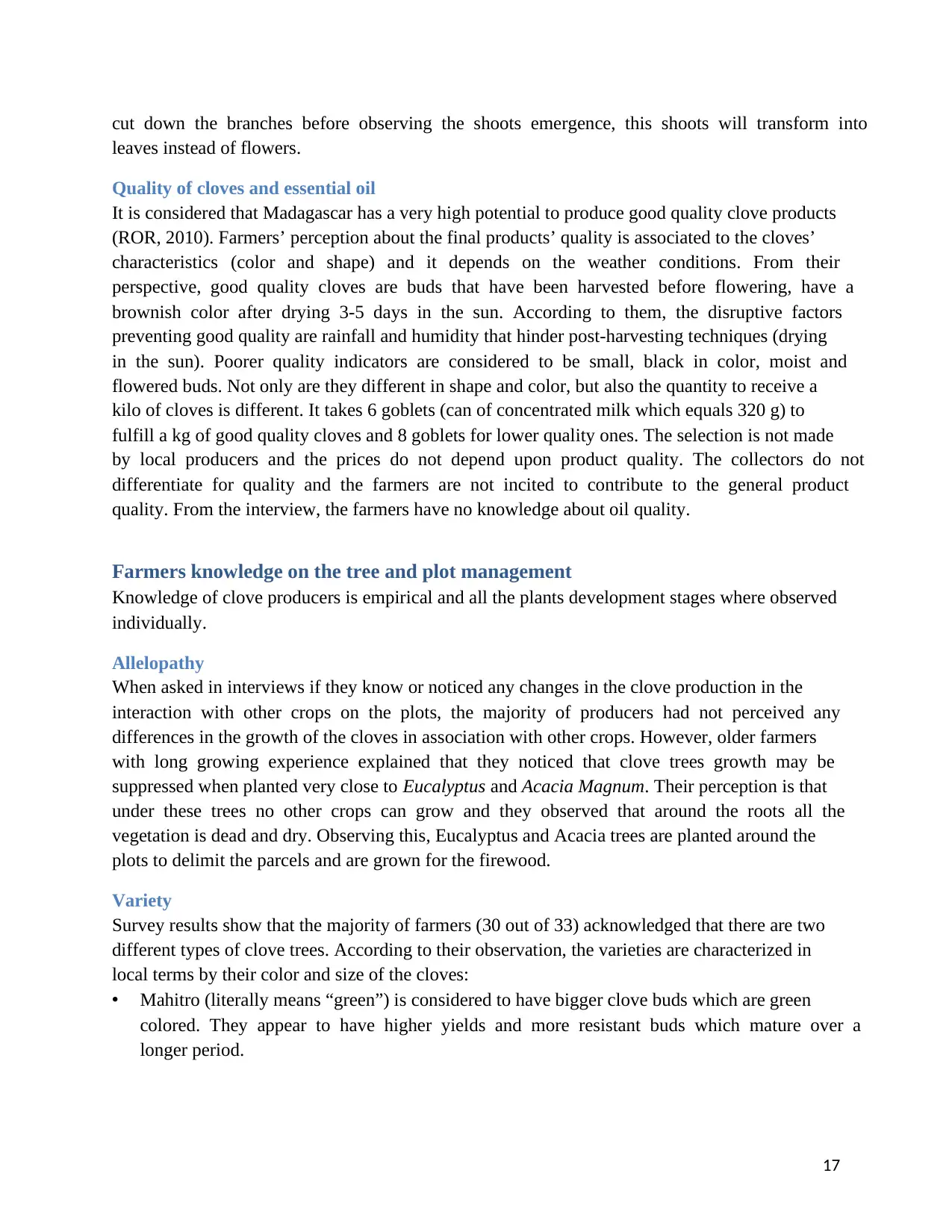
17
cut down the branches before observing the shoots emergence, this shoots will transform into
leaves instead of flowers.
Quality of cloves and essential oil
It is considered that Madagascar has a very high potential to produce good quality clove products
(ROR, 2010). Farmers’ perception about the final products’ quality is associated to the cloves’
characteristics (color and shape) and it depends on the weather conditions. From their
perspective, good quality cloves are buds that have been harvested before flowering, have a
brownish color after drying 3-5 days in the sun. According to them, the disruptive factors
preventing good quality are rainfall and humidity that hinder post-harvesting techniques (drying
in the sun). Poorer quality indicators are considered to be small, black in color, moist and
flowered buds. Not only are they different in shape and color, but also the quantity to receive a
kilo of cloves is different. It takes 6 goblets (can of concentrated milk which equals 320 g) to
fulfill a kg of good quality cloves and 8 goblets for lower quality ones. The selection is not made
by local producers and the prices do not depend upon product quality. The collectors do not
differentiate for quality and the farmers are not incited to contribute to the general product
quality. From the interview, the farmers have no knowledge about oil quality.
Farmers knowledge on the tree and plot management
Knowledge of clove producers is empirical and all the plants development stages where observed
individually.
Allelopathy
When asked in interviews if they know or noticed any changes in the clove production in the
interaction with other crops on the plots, the majority of producers had not perceived any
differences in the growth of the cloves in association with other crops. However, older farmers
with long growing experience explained that they noticed that clove trees growth may be
suppressed when planted very close to Eucalyptus and Acacia Magnum. Their perception is that
under these trees no other crops can grow and they observed that around the roots all the
vegetation is dead and dry. Observing this, Eucalyptus and Acacia trees are planted around the
plots to delimit the parcels and are grown for the firewood.
Variety
Survey results show that the majority of farmers (30 out of 33) acknowledged that there are two
different types of clove trees. According to their observation, the varieties are characterized in
local terms by their color and size of the cloves:
• Mahitro (literally means “green”) is considered to have bigger clove buds which are green
colored. They appear to have higher yields and more resistant buds which mature over a
longer period.
cut down the branches before observing the shoots emergence, this shoots will transform into
leaves instead of flowers.
Quality of cloves and essential oil
It is considered that Madagascar has a very high potential to produce good quality clove products
(ROR, 2010). Farmers’ perception about the final products’ quality is associated to the cloves’
characteristics (color and shape) and it depends on the weather conditions. From their
perspective, good quality cloves are buds that have been harvested before flowering, have a
brownish color after drying 3-5 days in the sun. According to them, the disruptive factors
preventing good quality are rainfall and humidity that hinder post-harvesting techniques (drying
in the sun). Poorer quality indicators are considered to be small, black in color, moist and
flowered buds. Not only are they different in shape and color, but also the quantity to receive a
kilo of cloves is different. It takes 6 goblets (can of concentrated milk which equals 320 g) to
fulfill a kg of good quality cloves and 8 goblets for lower quality ones. The selection is not made
by local producers and the prices do not depend upon product quality. The collectors do not
differentiate for quality and the farmers are not incited to contribute to the general product
quality. From the interview, the farmers have no knowledge about oil quality.
Farmers knowledge on the tree and plot management
Knowledge of clove producers is empirical and all the plants development stages where observed
individually.
Allelopathy
When asked in interviews if they know or noticed any changes in the clove production in the
interaction with other crops on the plots, the majority of producers had not perceived any
differences in the growth of the cloves in association with other crops. However, older farmers
with long growing experience explained that they noticed that clove trees growth may be
suppressed when planted very close to Eucalyptus and Acacia Magnum. Their perception is that
under these trees no other crops can grow and they observed that around the roots all the
vegetation is dead and dry. Observing this, Eucalyptus and Acacia trees are planted around the
plots to delimit the parcels and are grown for the firewood.
Variety
Survey results show that the majority of farmers (30 out of 33) acknowledged that there are two
different types of clove trees. According to their observation, the varieties are characterized in
local terms by their color and size of the cloves:
• Mahitro (literally means “green”) is considered to have bigger clove buds which are green
colored. They appear to have higher yields and more resistant buds which mature over a
longer period.
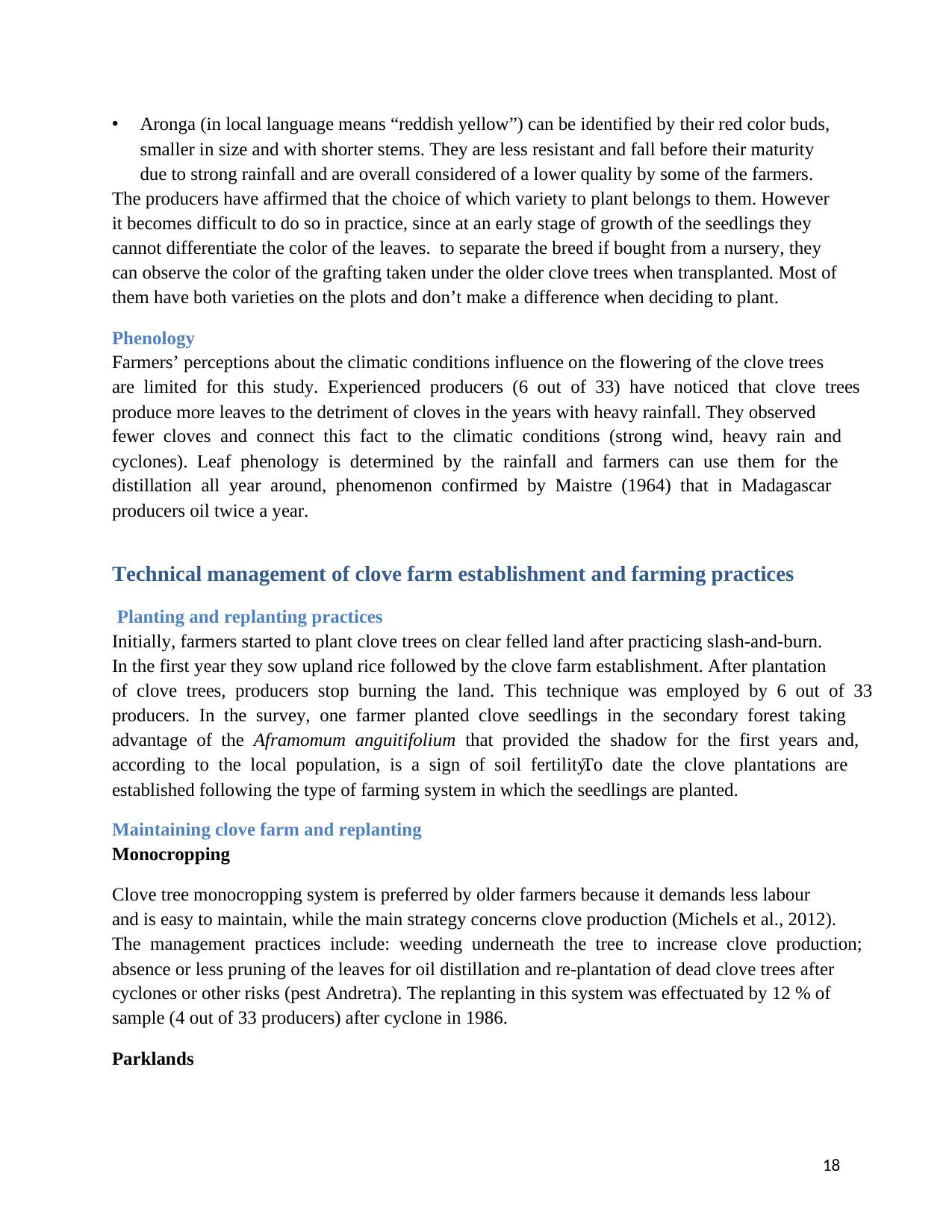
18
• Aronga (in local language means “reddish yellow”) can be identified by their red color buds,
smaller in size and with shorter stems. They are less resistant and fall before their maturity
due to strong rainfall and are overall considered of a lower quality by some of the farmers.
The producers have affirmed that the choice of which variety to plant belongs to them. However
it becomes difficult to do so in practice, since at an early stage of growth of the seedlings they
cannot differentiate the color of the leaves. to separate the breed if bought from a nursery, they
can observe the color of the grafting taken under the older clove trees when transplanted. Most of
them have both varieties on the plots and don’t make a difference when deciding to plant.
Phenology
Farmers’ perceptions about the climatic conditions influence on the flowering of the clove trees
are limited for this study. Experienced producers (6 out of 33) have noticed that clove trees
produce more leaves to the detriment of cloves in the years with heavy rainfall. They observed
fewer cloves and connect this fact to the climatic conditions (strong wind, heavy rain and
cyclones). Leaf phenology is determined by the rainfall and farmers can use them for the
distillation all year around, phenomenon confirmed by Maistre (1964) that in Madagascar
producers oil twice a year.
Technical management of clove farm establishment and farming practices
Planting and replanting practices
Initially, farmers started to plant clove trees on clear felled land after practicing slash-and-burn.
In the first year they sow upland rice followed by the clove farm establishment. After plantation
of clove trees, producers stop burning the land. This technique was employed by 6 out of 33
producers. In the survey, one farmer planted clove seedlings in the secondary forest taking
advantage of the Aframomum anguitifolium that provided the shadow for the first years and,
according to the local population, is a sign of soil fertility.To date the clove plantations are
established following the type of farming system in which the seedlings are planted.
Maintaining clove farm and replanting
Monocropping
Clove tree monocropping system is preferred by older farmers because it demands less labour
and is easy to maintain, while the main strategy concerns clove production (Michels et al., 2012).
The management practices include: weeding underneath the tree to increase clove production;
absence or less pruning of the leaves for oil distillation and re-plantation of dead clove trees after
cyclones or other risks (pest Andretra). The replanting in this system was effectuated by 12 % of
sample (4 out of 33 producers) after cyclone in 1986.
Parklands
• Aronga (in local language means “reddish yellow”) can be identified by their red color buds,
smaller in size and with shorter stems. They are less resistant and fall before their maturity
due to strong rainfall and are overall considered of a lower quality by some of the farmers.
The producers have affirmed that the choice of which variety to plant belongs to them. However
it becomes difficult to do so in practice, since at an early stage of growth of the seedlings they
cannot differentiate the color of the leaves. to separate the breed if bought from a nursery, they
can observe the color of the grafting taken under the older clove trees when transplanted. Most of
them have both varieties on the plots and don’t make a difference when deciding to plant.
Phenology
Farmers’ perceptions about the climatic conditions influence on the flowering of the clove trees
are limited for this study. Experienced producers (6 out of 33) have noticed that clove trees
produce more leaves to the detriment of cloves in the years with heavy rainfall. They observed
fewer cloves and connect this fact to the climatic conditions (strong wind, heavy rain and
cyclones). Leaf phenology is determined by the rainfall and farmers can use them for the
distillation all year around, phenomenon confirmed by Maistre (1964) that in Madagascar
producers oil twice a year.
Technical management of clove farm establishment and farming practices
Planting and replanting practices
Initially, farmers started to plant clove trees on clear felled land after practicing slash-and-burn.
In the first year they sow upland rice followed by the clove farm establishment. After plantation
of clove trees, producers stop burning the land. This technique was employed by 6 out of 33
producers. In the survey, one farmer planted clove seedlings in the secondary forest taking
advantage of the Aframomum anguitifolium that provided the shadow for the first years and,
according to the local population, is a sign of soil fertility.To date the clove plantations are
established following the type of farming system in which the seedlings are planted.
Maintaining clove farm and replanting
Monocropping
Clove tree monocropping system is preferred by older farmers because it demands less labour
and is easy to maintain, while the main strategy concerns clove production (Michels et al., 2012).
The management practices include: weeding underneath the tree to increase clove production;
absence or less pruning of the leaves for oil distillation and re-plantation of dead clove trees after
cyclones or other risks (pest Andretra). The replanting in this system was effectuated by 12 % of
sample (4 out of 33 producers) after cyclone in 1986.
Parklands
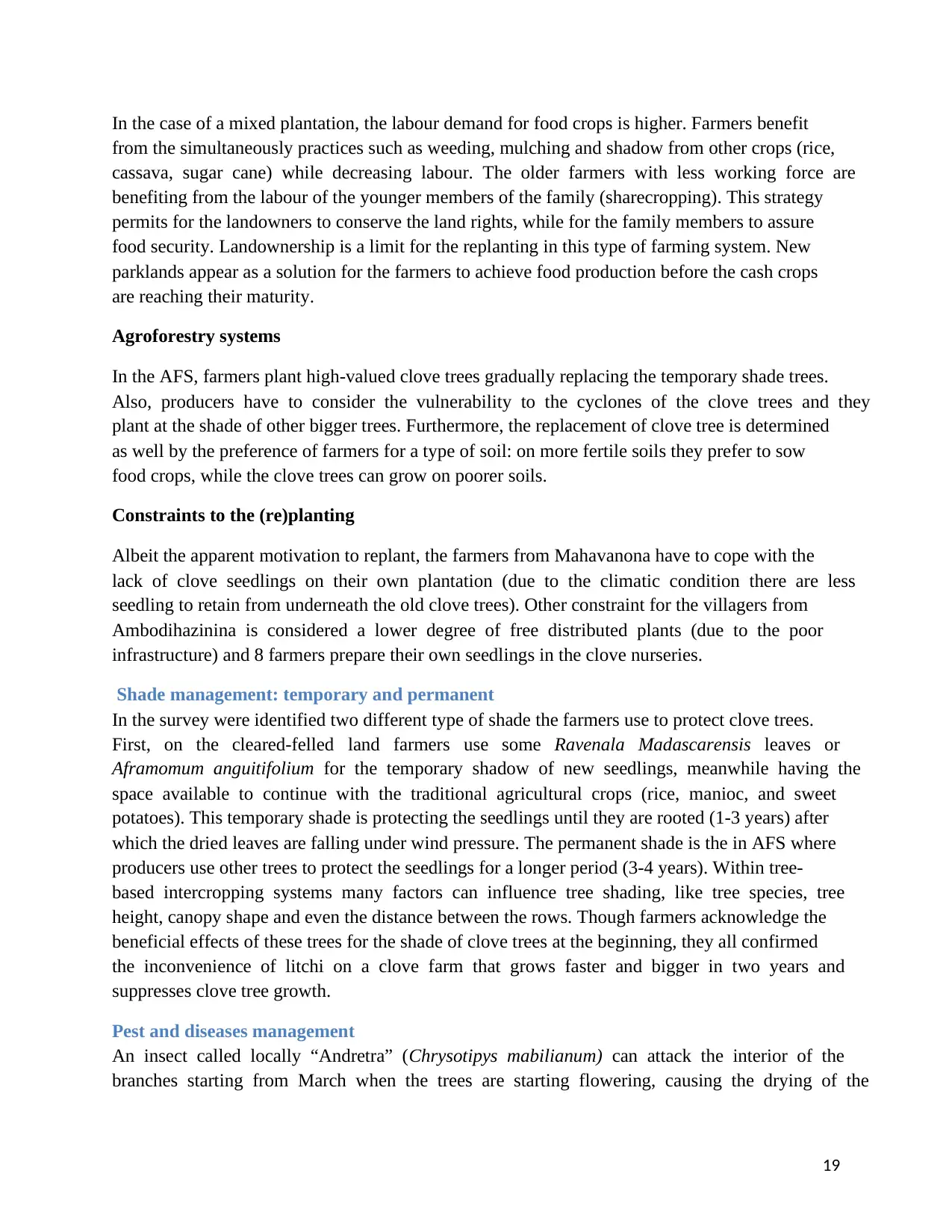
19
In the case of a mixed plantation, the labour demand for food crops is higher. Farmers benefit
from the simultaneously practices such as weeding, mulching and shadow from other crops (rice,
cassava, sugar cane) while decreasing labour. The older farmers with less working force are
benefiting from the labour of the younger members of the family (sharecropping). This strategy
permits for the landowners to conserve the land rights, while for the family members to assure
food security. Landownership is a limit for the replanting in this type of farming system. New
parklands appear as a solution for the farmers to achieve food production before the cash crops
are reaching their maturity.
Agroforestry systems
In the AFS, farmers plant high-valued clove trees gradually replacing the temporary shade trees.
Also, producers have to consider the vulnerability to the cyclones of the clove trees and they
plant at the shade of other bigger trees. Furthermore, the replacement of clove tree is determined
as well by the preference of farmers for a type of soil: on more fertile soils they prefer to sow
food crops, while the clove trees can grow on poorer soils.
Constraints to the (re)planting
Albeit the apparent motivation to replant, the farmers from Mahavanona have to cope with the
lack of clove seedlings on their own plantation (due to the climatic condition there are less
seedling to retain from underneath the old clove trees). Other constraint for the villagers from
Ambodihazinina is considered a lower degree of free distributed plants (due to the poor
infrastructure) and 8 farmers prepare their own seedlings in the clove nurseries.
Shade management: temporary and permanent
In the survey were identified two different type of shade the farmers use to protect clove trees.
First, on the cleared-felled land farmers use some Ravenala Madascarensis leaves or
Aframomum anguitifolium for the temporary shadow of new seedlings, meanwhile having the
space available to continue with the traditional agricultural crops (rice, manioc, and sweet
potatoes). This temporary shade is protecting the seedlings until they are rooted (1-3 years) after
which the dried leaves are falling under wind pressure. The permanent shade is the in AFS where
producers use other trees to protect the seedlings for a longer period (3-4 years). Within tree-
based intercropping systems many factors can influence tree shading, like tree species, tree
height, canopy shape and even the distance between the rows. Though farmers acknowledge the
beneficial effects of these trees for the shade of clove trees at the beginning, they all confirmed
the inconvenience of litchi on a clove farm that grows faster and bigger in two years and
suppresses clove tree growth.
Pest and diseases management
An insect called locally “Andretra” (Chrysotipys mabilianum) can attack the interior of the
branches starting from March when the trees are starting flowering, causing the drying of the
In the case of a mixed plantation, the labour demand for food crops is higher. Farmers benefit
from the simultaneously practices such as weeding, mulching and shadow from other crops (rice,
cassava, sugar cane) while decreasing labour. The older farmers with less working force are
benefiting from the labour of the younger members of the family (sharecropping). This strategy
permits for the landowners to conserve the land rights, while for the family members to assure
food security. Landownership is a limit for the replanting in this type of farming system. New
parklands appear as a solution for the farmers to achieve food production before the cash crops
are reaching their maturity.
Agroforestry systems
In the AFS, farmers plant high-valued clove trees gradually replacing the temporary shade trees.
Also, producers have to consider the vulnerability to the cyclones of the clove trees and they
plant at the shade of other bigger trees. Furthermore, the replacement of clove tree is determined
as well by the preference of farmers for a type of soil: on more fertile soils they prefer to sow
food crops, while the clove trees can grow on poorer soils.
Constraints to the (re)planting
Albeit the apparent motivation to replant, the farmers from Mahavanona have to cope with the
lack of clove seedlings on their own plantation (due to the climatic condition there are less
seedling to retain from underneath the old clove trees). Other constraint for the villagers from
Ambodihazinina is considered a lower degree of free distributed plants (due to the poor
infrastructure) and 8 farmers prepare their own seedlings in the clove nurseries.
Shade management: temporary and permanent
In the survey were identified two different type of shade the farmers use to protect clove trees.
First, on the cleared-felled land farmers use some Ravenala Madascarensis leaves or
Aframomum anguitifolium for the temporary shadow of new seedlings, meanwhile having the
space available to continue with the traditional agricultural crops (rice, manioc, and sweet
potatoes). This temporary shade is protecting the seedlings until they are rooted (1-3 years) after
which the dried leaves are falling under wind pressure. The permanent shade is the in AFS where
producers use other trees to protect the seedlings for a longer period (3-4 years). Within tree-
based intercropping systems many factors can influence tree shading, like tree species, tree
height, canopy shape and even the distance between the rows. Though farmers acknowledge the
beneficial effects of these trees for the shade of clove trees at the beginning, they all confirmed
the inconvenience of litchi on a clove farm that grows faster and bigger in two years and
suppresses clove tree growth.
Pest and diseases management
An insect called locally “Andretra” (Chrysotipys mabilianum) can attack the interior of the
branches starting from March when the trees are starting flowering, causing the drying of the
Paraphrase This Document
Need a fresh take? Get an instant paraphrase of this document with our AI Paraphraser
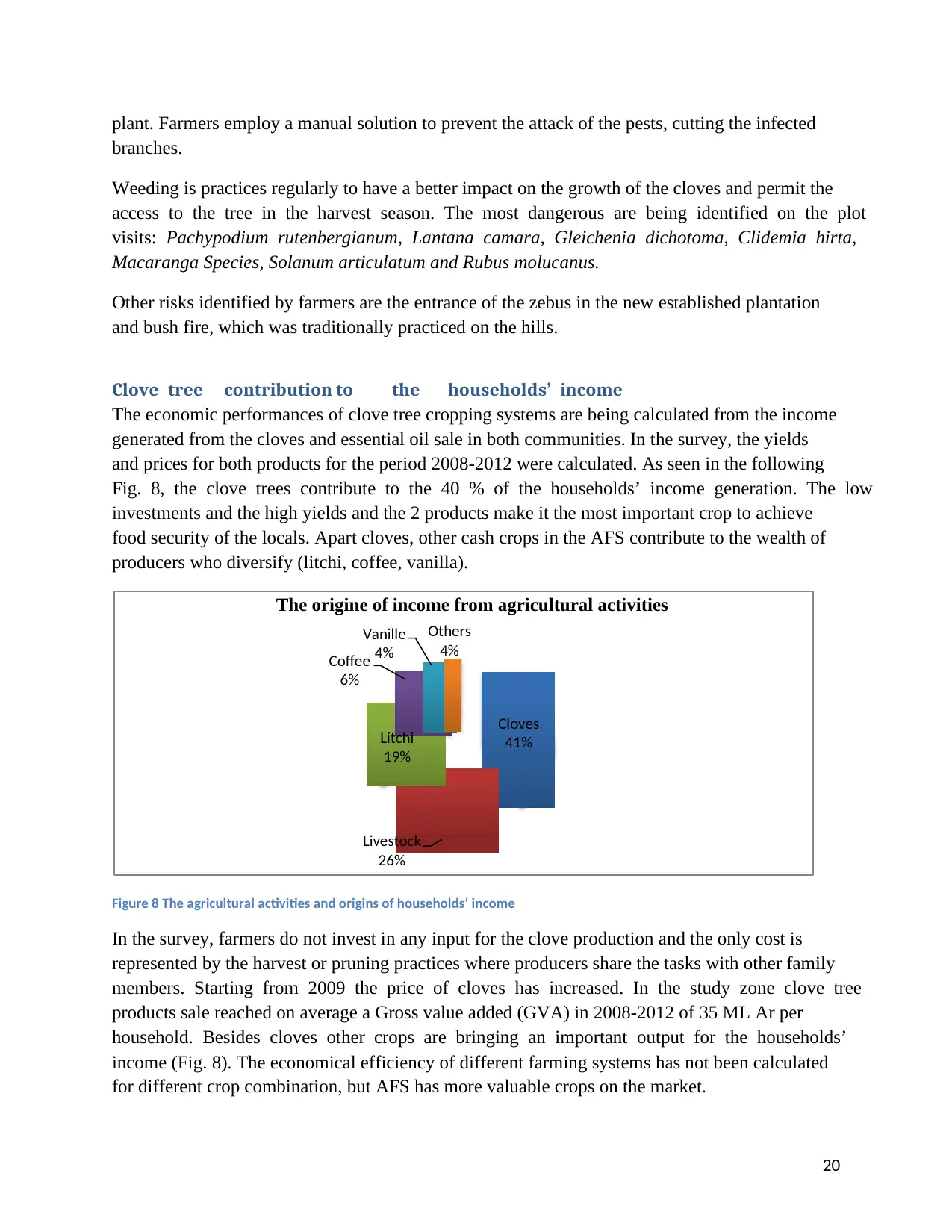
20
plant. Farmers employ a manual solution to prevent the attack of the pests, cutting the infected
branches.
Weeding is practices regularly to have a better impact on the growth of the cloves and permit the
access to the tree in the harvest season. The most dangerous are being identified on the plot
visits: Pachypodium rutenbergianum, Lantana camara, Gleichenia dichotoma, Clidemia hirta,
Macaranga Species, Solanum articulatum and Rubus molucanus.
Other risks identified by farmers are the entrance of the zebus in the new established plantation
and bush fire, which was traditionally practiced on the hills.
Clove tree contribution to the households’ income
The economic performances of clove tree cropping systems are being calculated from the income
generated from the cloves and essential oil sale in both communities. In the survey, the yields
and prices for both products for the period 2008-2012 were calculated. As seen in the following
Fig. 8, the clove trees contribute to the 40 % of the households’ income generation. The low
investments and the high yields and the 2 products make it the most important crop to achieve
food security of the locals. Apart cloves, other cash crops in the AFS contribute to the wealth of
producers who diversify (litchi, coffee, vanilla).
Figure 8 The agricultural activities and origins of households’ income
In the survey, farmers do not invest in any input for the clove production and the only cost is
represented by the harvest or pruning practices where producers share the tasks with other family
members. Starting from 2009 the price of cloves has increased. In the study zone clove tree
products sale reached on average a Gross value added (GVA) in 2008-2012 of 35 ML Ar per
household. Besides cloves other crops are bringing an important output for the households’
income (Fig. 8). The economical efficiency of different farming systems has not been calculated
for different crop combination, but AFS has more valuable crops on the market.
Cloves
41%
Livestock
26%
Litchi
19%
Coffee
6%
Vanille
4%
Others
4%
The origine of income from agricultural activities
plant. Farmers employ a manual solution to prevent the attack of the pests, cutting the infected
branches.
Weeding is practices regularly to have a better impact on the growth of the cloves and permit the
access to the tree in the harvest season. The most dangerous are being identified on the plot
visits: Pachypodium rutenbergianum, Lantana camara, Gleichenia dichotoma, Clidemia hirta,
Macaranga Species, Solanum articulatum and Rubus molucanus.
Other risks identified by farmers are the entrance of the zebus in the new established plantation
and bush fire, which was traditionally practiced on the hills.
Clove tree contribution to the households’ income
The economic performances of clove tree cropping systems are being calculated from the income
generated from the cloves and essential oil sale in both communities. In the survey, the yields
and prices for both products for the period 2008-2012 were calculated. As seen in the following
Fig. 8, the clove trees contribute to the 40 % of the households’ income generation. The low
investments and the high yields and the 2 products make it the most important crop to achieve
food security of the locals. Apart cloves, other cash crops in the AFS contribute to the wealth of
producers who diversify (litchi, coffee, vanilla).
Figure 8 The agricultural activities and origins of households’ income
In the survey, farmers do not invest in any input for the clove production and the only cost is
represented by the harvest or pruning practices where producers share the tasks with other family
members. Starting from 2009 the price of cloves has increased. In the study zone clove tree
products sale reached on average a Gross value added (GVA) in 2008-2012 of 35 ML Ar per
household. Besides cloves other crops are bringing an important output for the households’
income (Fig. 8). The economical efficiency of different farming systems has not been calculated
for different crop combination, but AFS has more valuable crops on the market.
Cloves
41%
Livestock
26%
Litchi
19%
Coffee
6%
Vanille
4%
Others
4%
The origine of income from agricultural activities
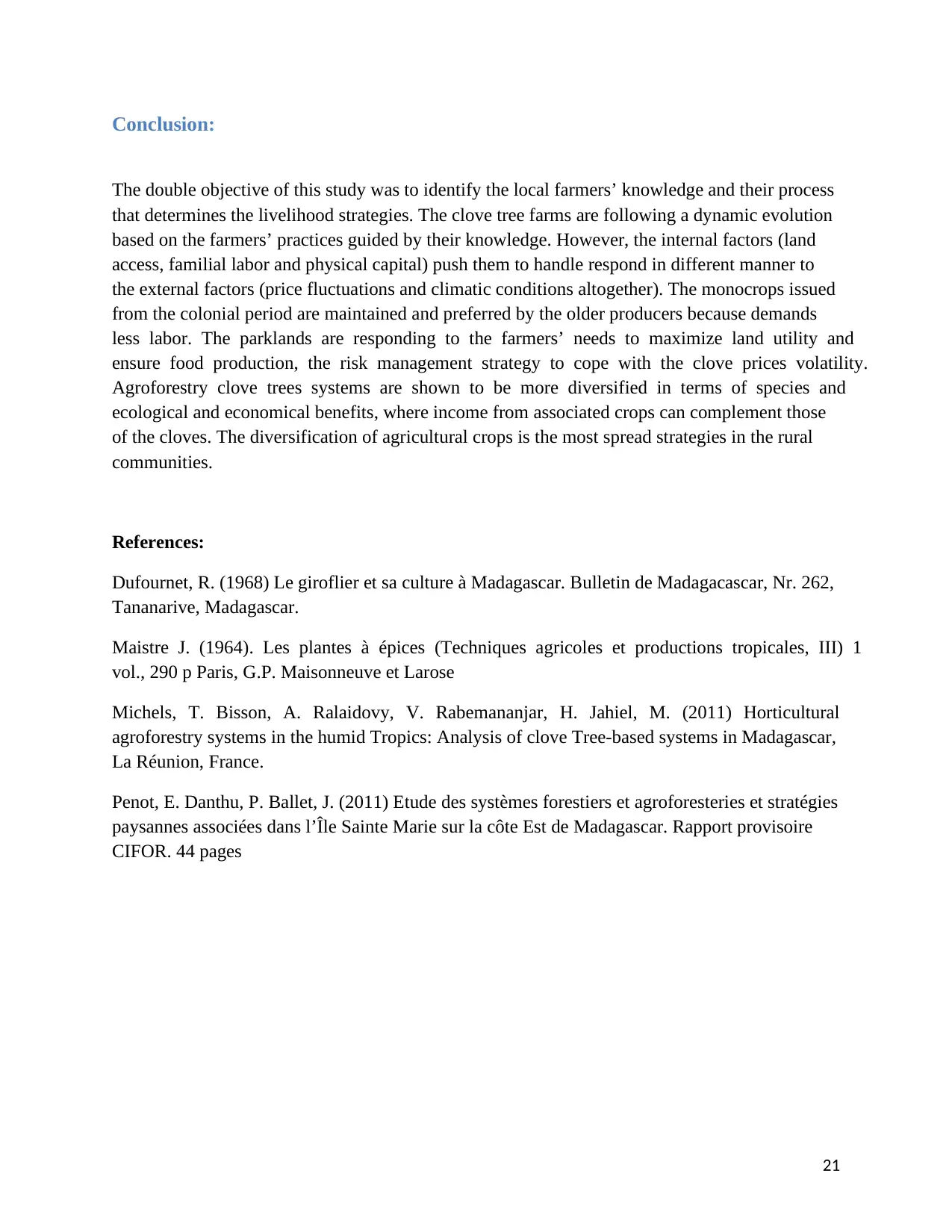
21
Conclusion:
The double objective of this study was to identify the local farmers’ knowledge and their process
that determines the livelihood strategies. The clove tree farms are following a dynamic evolution
based on the farmers’ practices guided by their knowledge. However, the internal factors (land
access, familial labor and physical capital) push them to handle respond in different manner to
the external factors (price fluctuations and climatic conditions altogether). The monocrops issued
from the colonial period are maintained and preferred by the older producers because demands
less labor. The parklands are responding to the farmers’ needs to maximize land utility and
ensure food production, the risk management strategy to cope with the clove prices volatility.
Agroforestry clove trees systems are shown to be more diversified in terms of species and
ecological and economical benefits, where income from associated crops can complement those
of the cloves. The diversification of agricultural crops is the most spread strategies in the rural
communities.
References:
Dufournet, R. (1968) Le giroflier et sa culture à Madagascar. Bulletin de Madagacascar, Nr. 262,
Tananarive, Madagascar.
Maistre J. (1964). Les plantes à épices (Techniques agricoles et productions tropicales, III) 1
vol., 290 p Paris, G.P. Maisonneuve et Larose
Michels, T. Bisson, A. Ralaidovy, V. Rabemananjar, H. Jahiel, M. (2011) Horticultural
agroforestry systems in the humid Tropics: Analysis of clove Tree-based systems in Madagascar,
La Réunion, France.
Penot, E. Danthu, P. Ballet, J. (2011) Etude des systèmes forestiers et agroforesteries et stratégies
paysannes associées dans l’Île Sainte Marie sur la côte Est de Madagascar. Rapport provisoire
CIFOR. 44 pages
Conclusion:
The double objective of this study was to identify the local farmers’ knowledge and their process
that determines the livelihood strategies. The clove tree farms are following a dynamic evolution
based on the farmers’ practices guided by their knowledge. However, the internal factors (land
access, familial labor and physical capital) push them to handle respond in different manner to
the external factors (price fluctuations and climatic conditions altogether). The monocrops issued
from the colonial period are maintained and preferred by the older producers because demands
less labor. The parklands are responding to the farmers’ needs to maximize land utility and
ensure food production, the risk management strategy to cope with the clove prices volatility.
Agroforestry clove trees systems are shown to be more diversified in terms of species and
ecological and economical benefits, where income from associated crops can complement those
of the cloves. The diversification of agricultural crops is the most spread strategies in the rural
communities.
References:
Dufournet, R. (1968) Le giroflier et sa culture à Madagascar. Bulletin de Madagacascar, Nr. 262,
Tananarive, Madagascar.
Maistre J. (1964). Les plantes à épices (Techniques agricoles et productions tropicales, III) 1
vol., 290 p Paris, G.P. Maisonneuve et Larose
Michels, T. Bisson, A. Ralaidovy, V. Rabemananjar, H. Jahiel, M. (2011) Horticultural
agroforestry systems in the humid Tropics: Analysis of clove Tree-based systems in Madagascar,
La Réunion, France.
Penot, E. Danthu, P. Ballet, J. (2011) Etude des systèmes forestiers et agroforesteries et stratégies
paysannes associées dans l’Île Sainte Marie sur la côte Est de Madagascar. Rapport provisoire
CIFOR. 44 pages
1 out of 21
Your All-in-One AI-Powered Toolkit for Academic Success.
+13062052269
info@desklib.com
Available 24*7 on WhatsApp / Email
![[object Object]](/_next/static/media/star-bottom.7253800d.svg)
Unlock your academic potential
© 2024 | Zucol Services PVT LTD | All rights reserved.